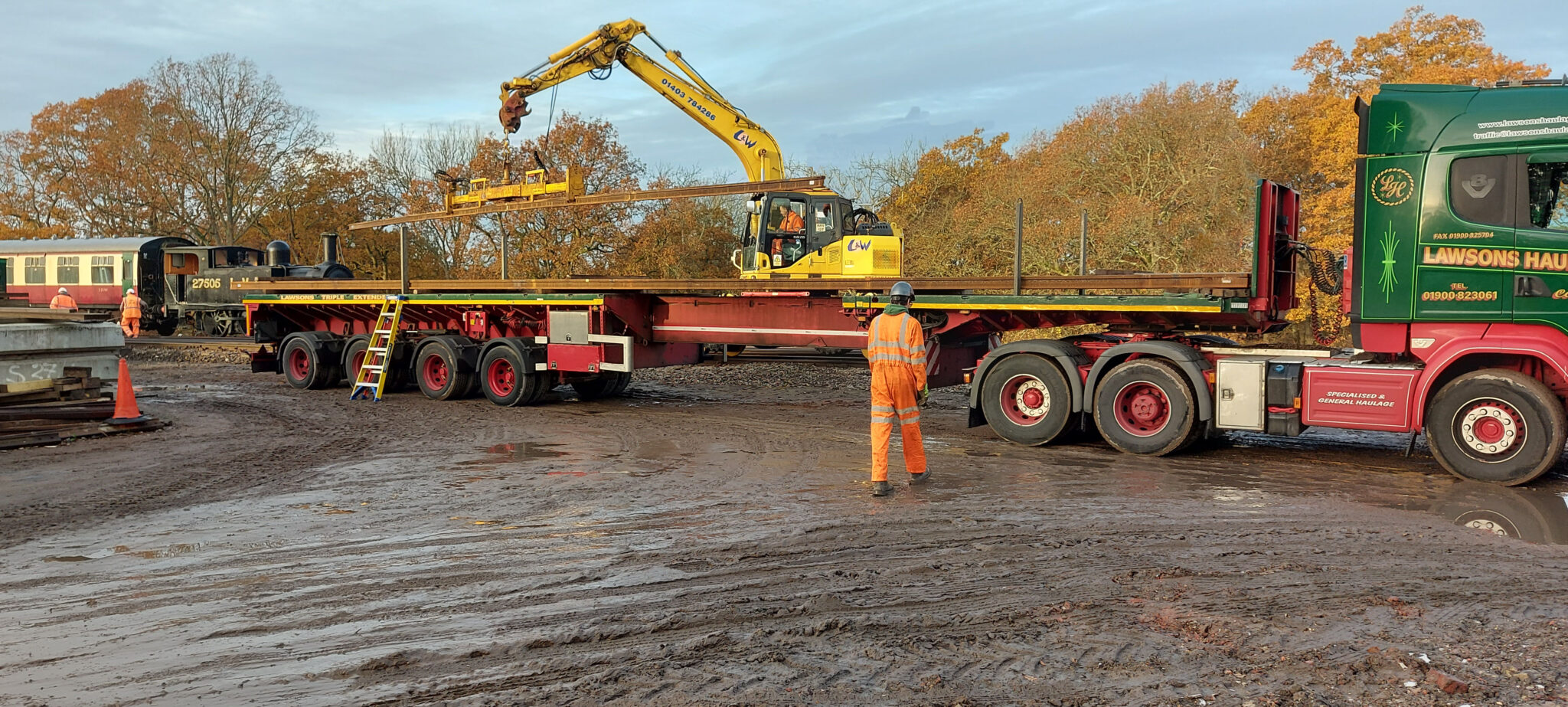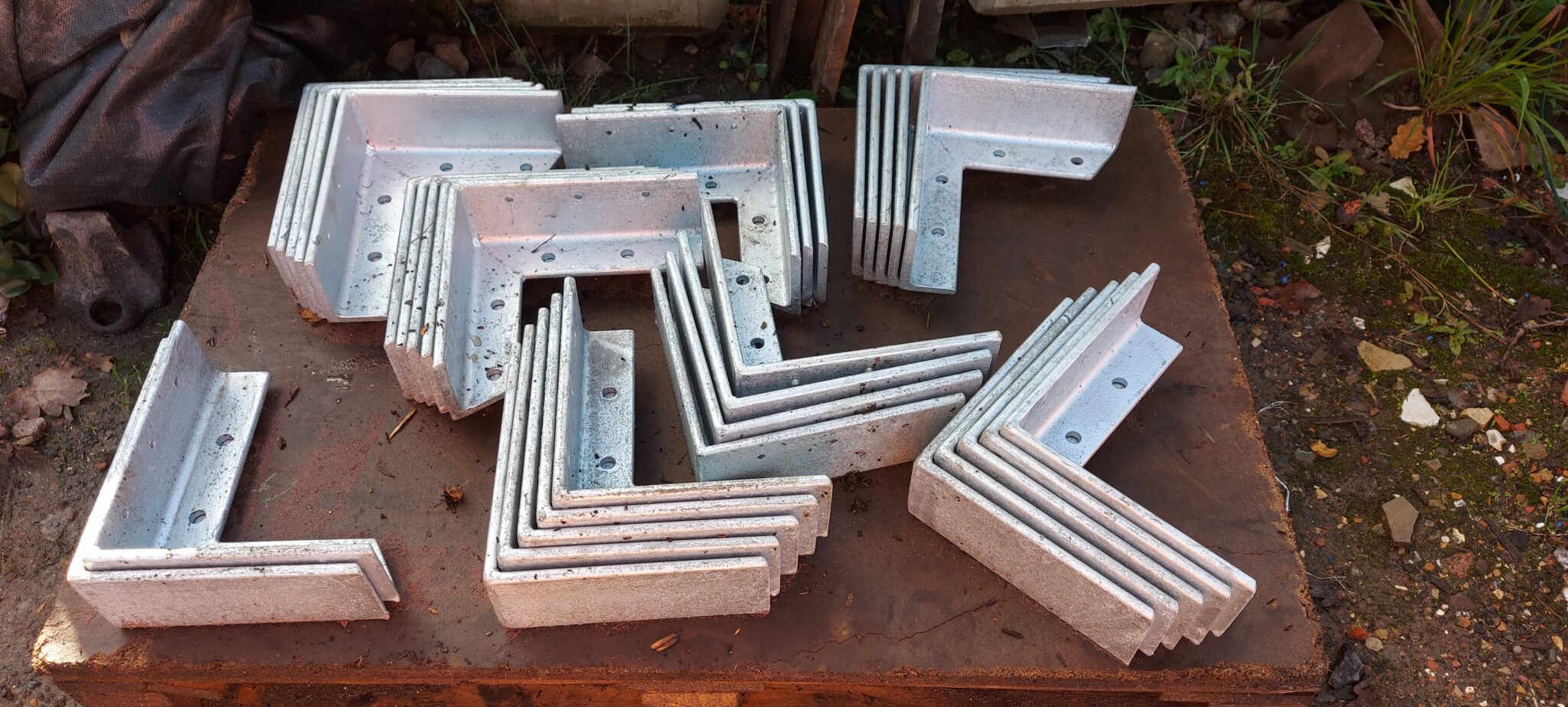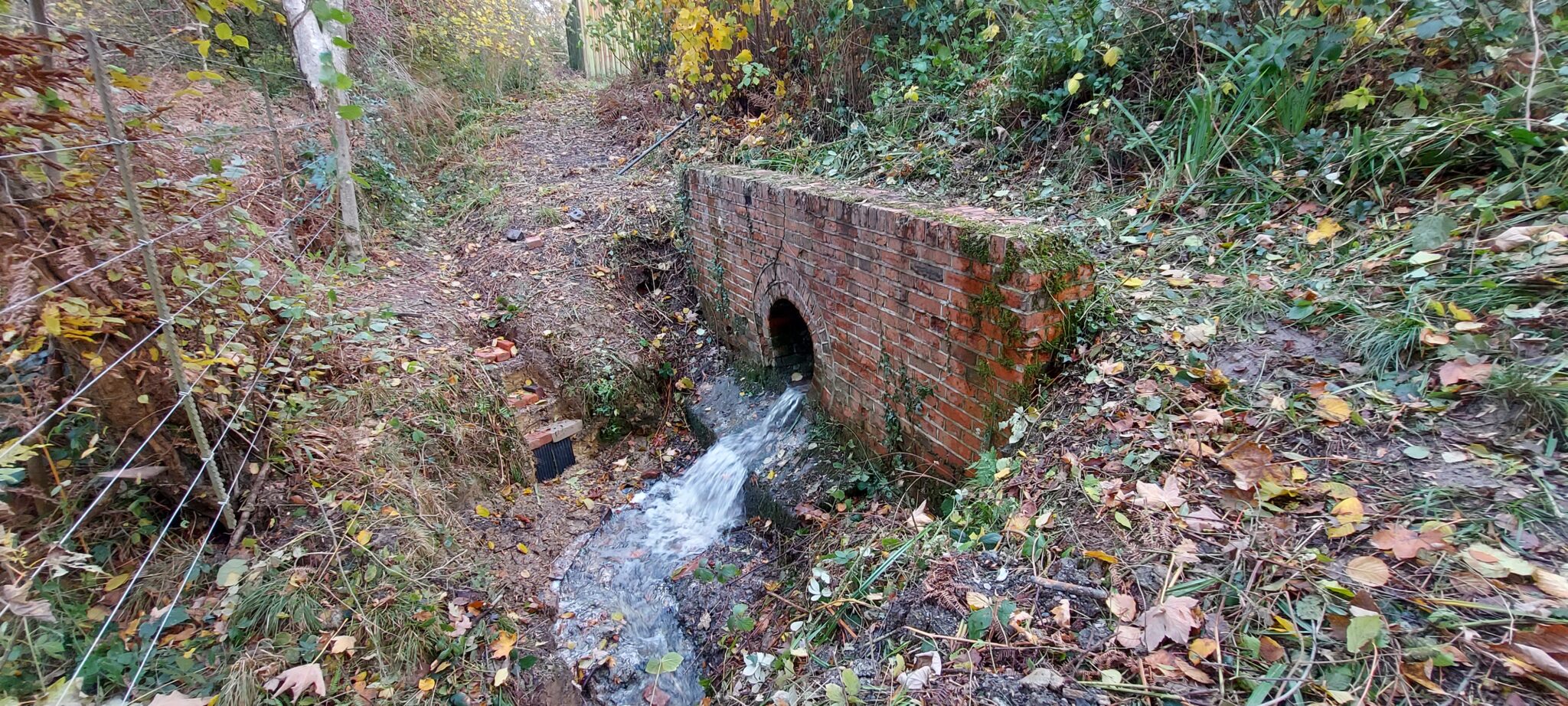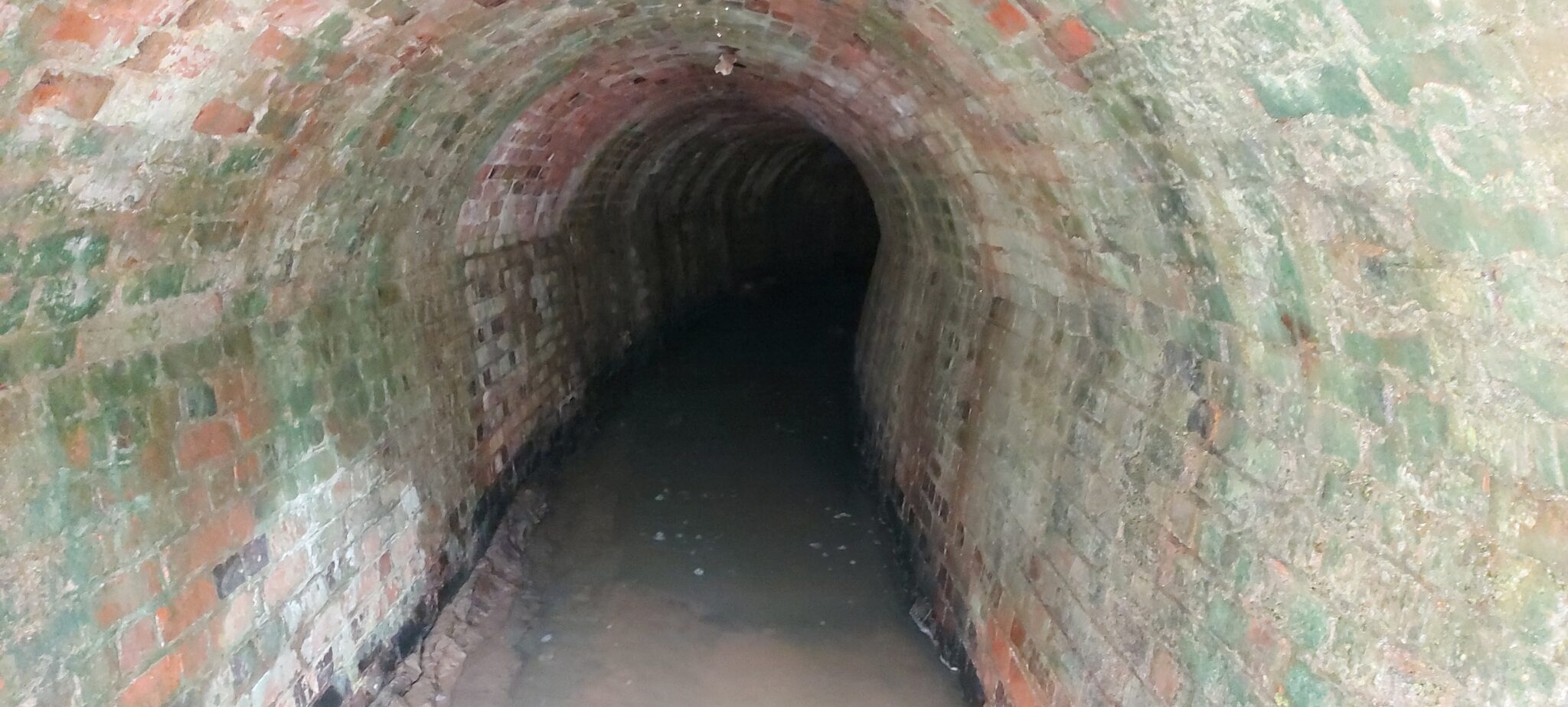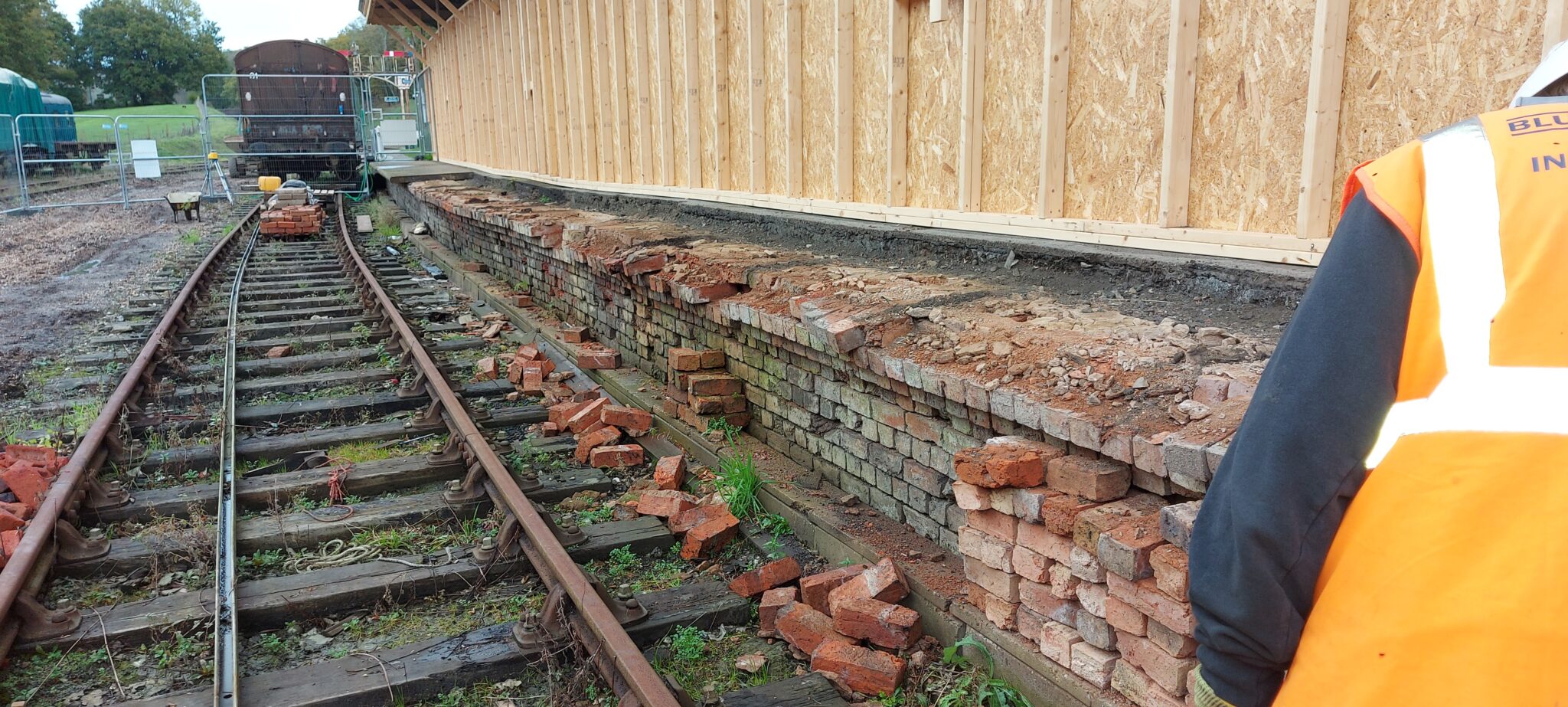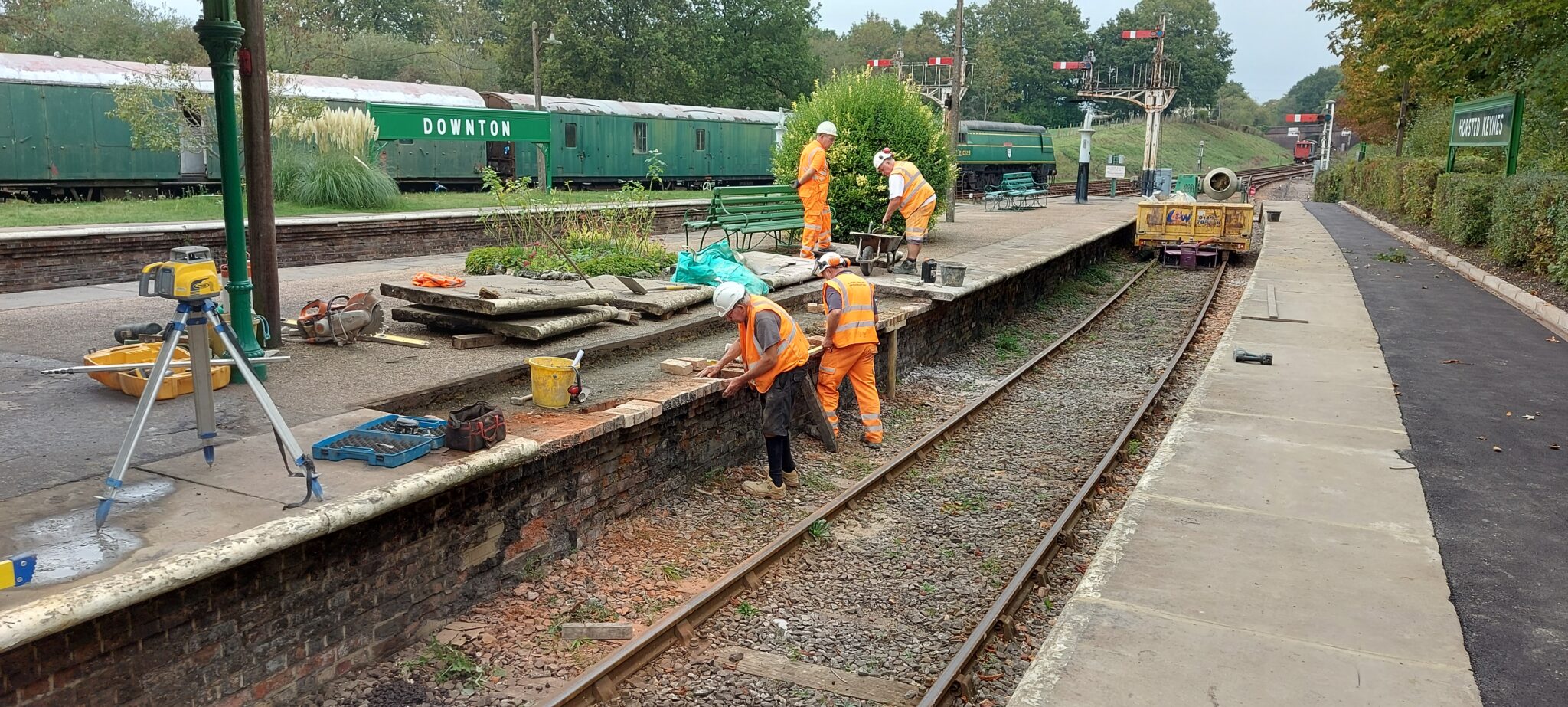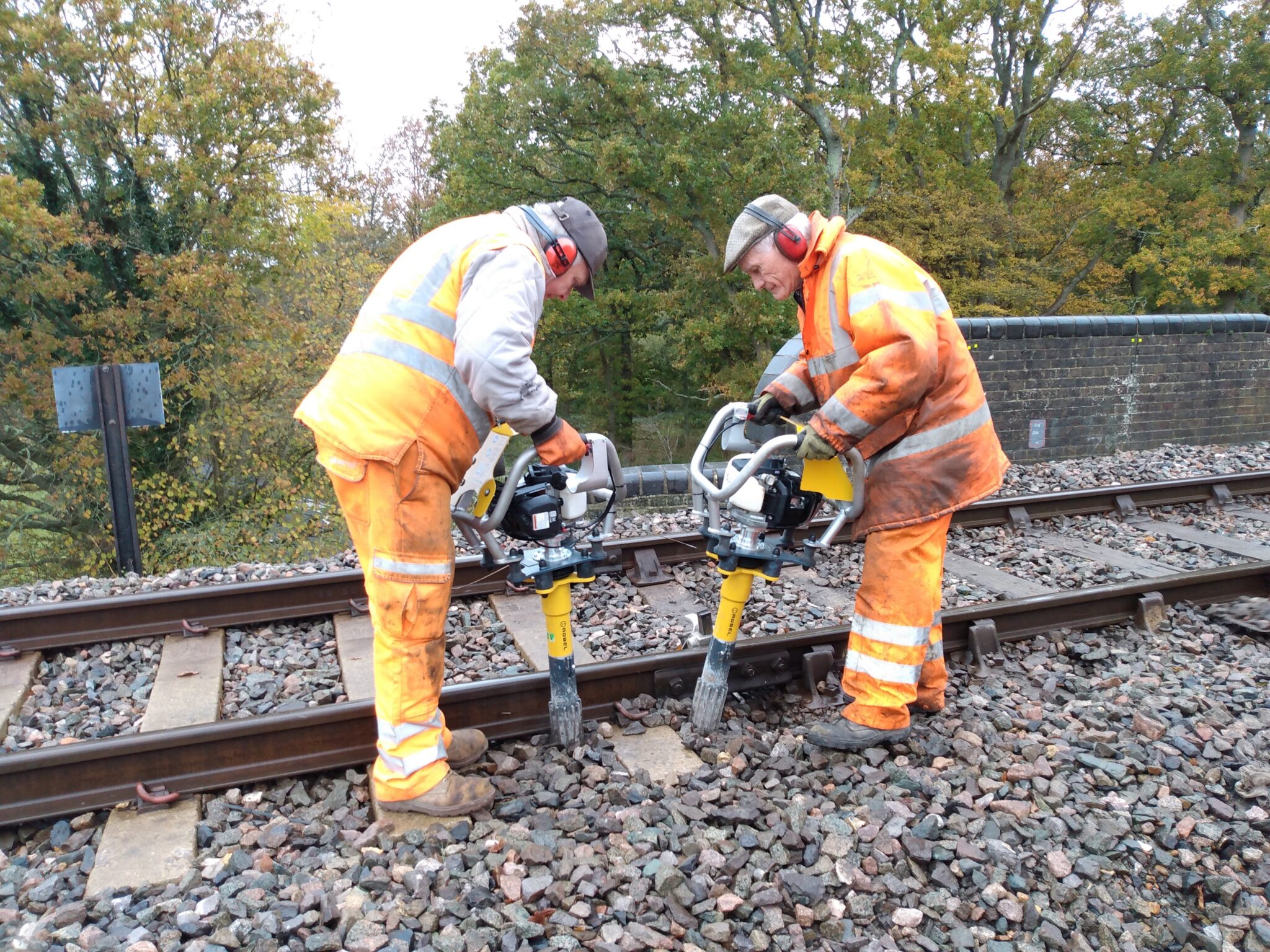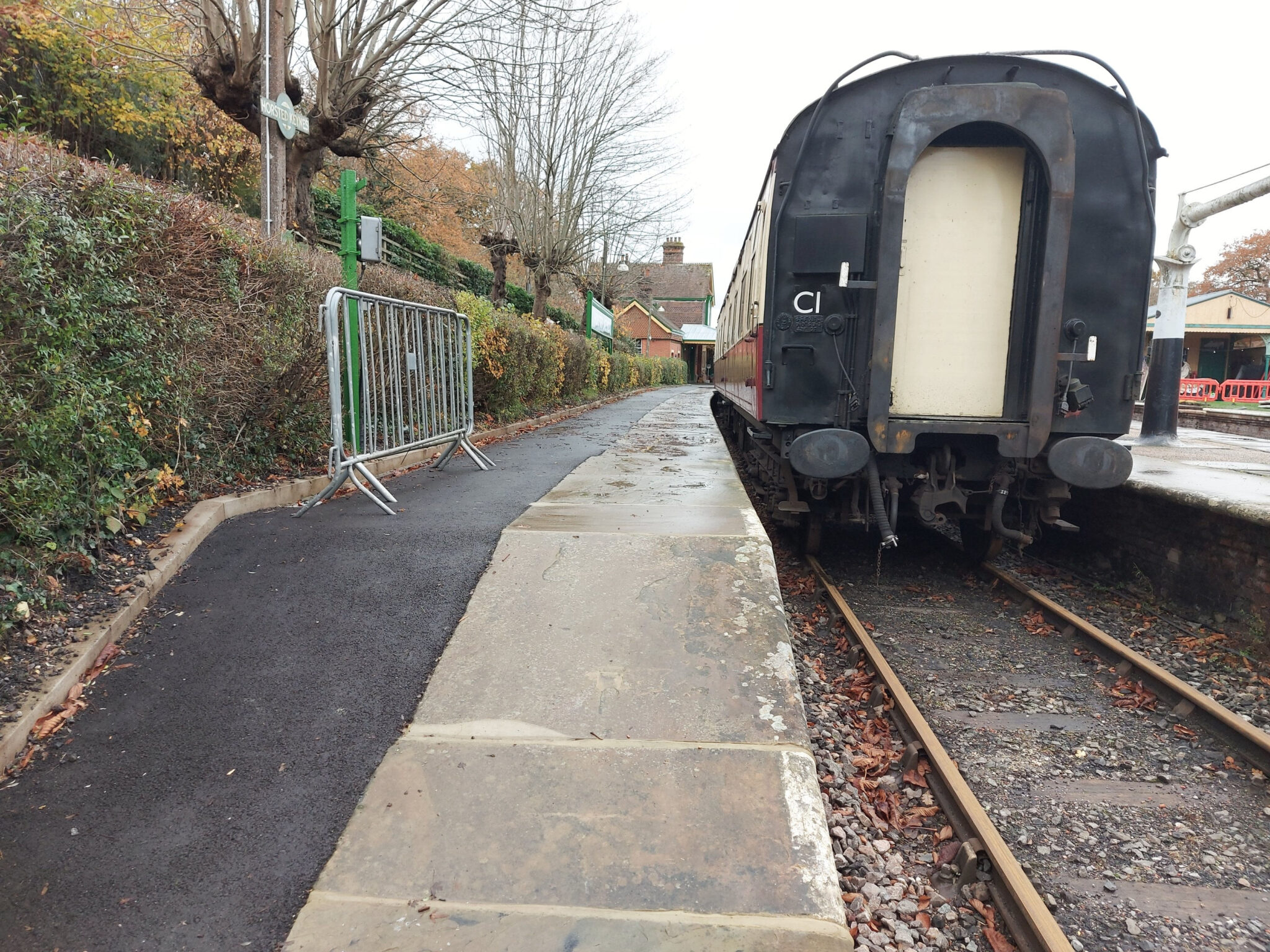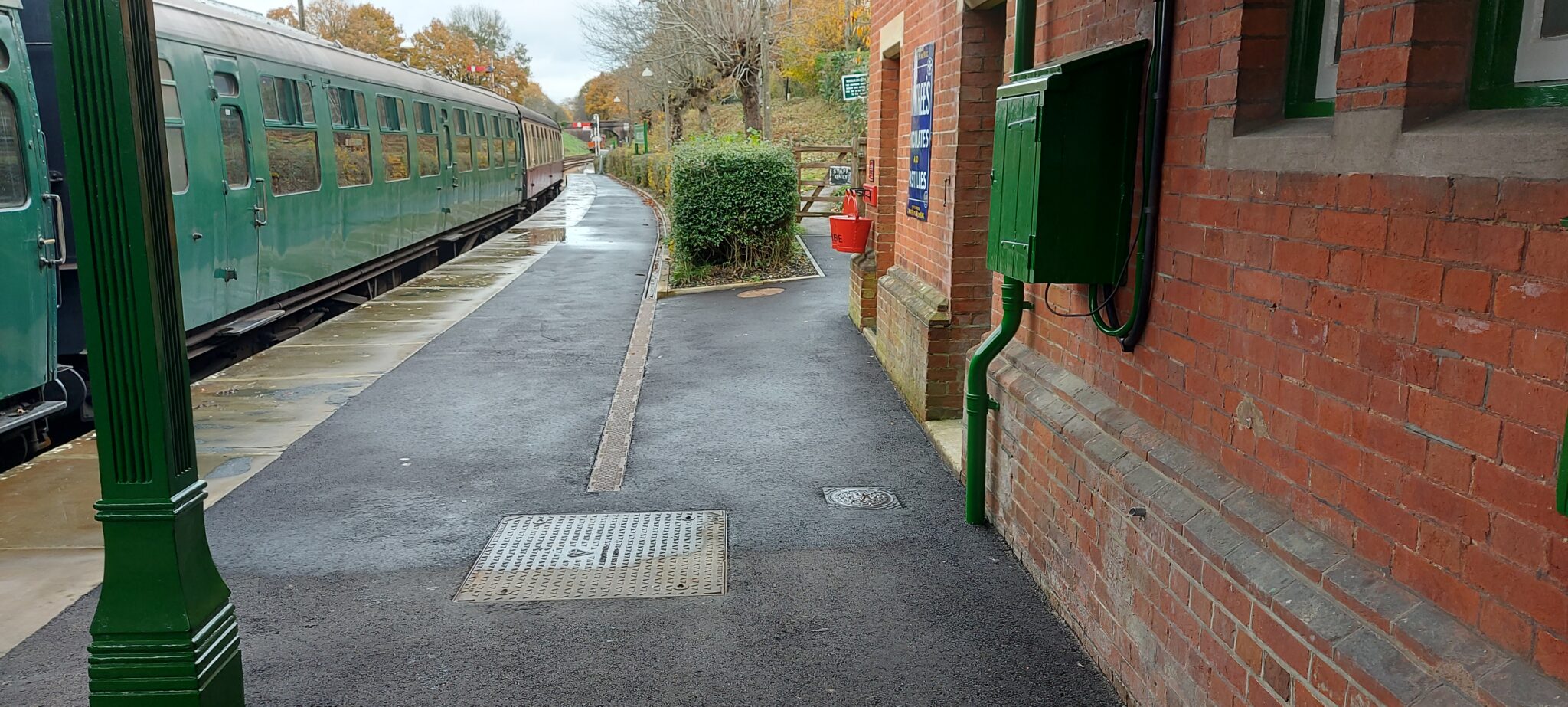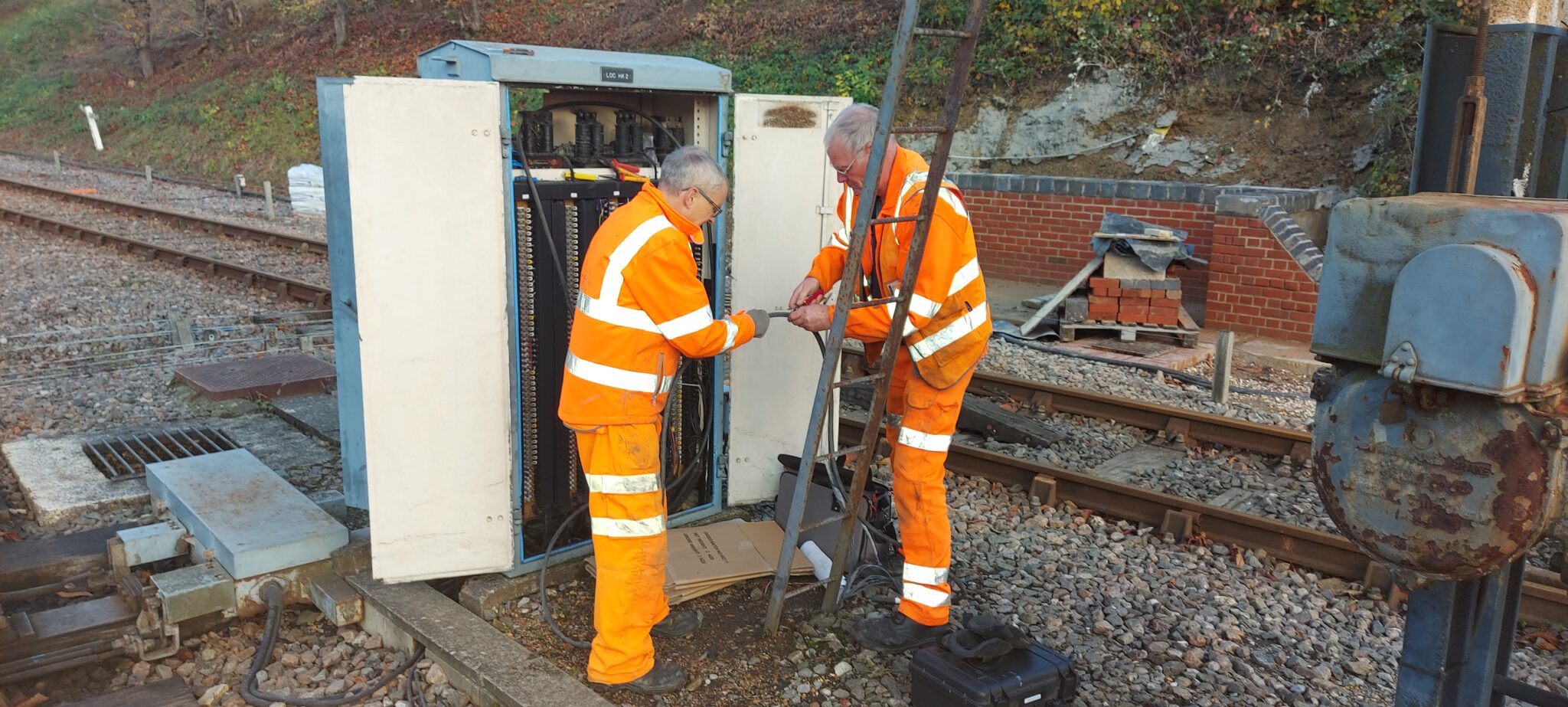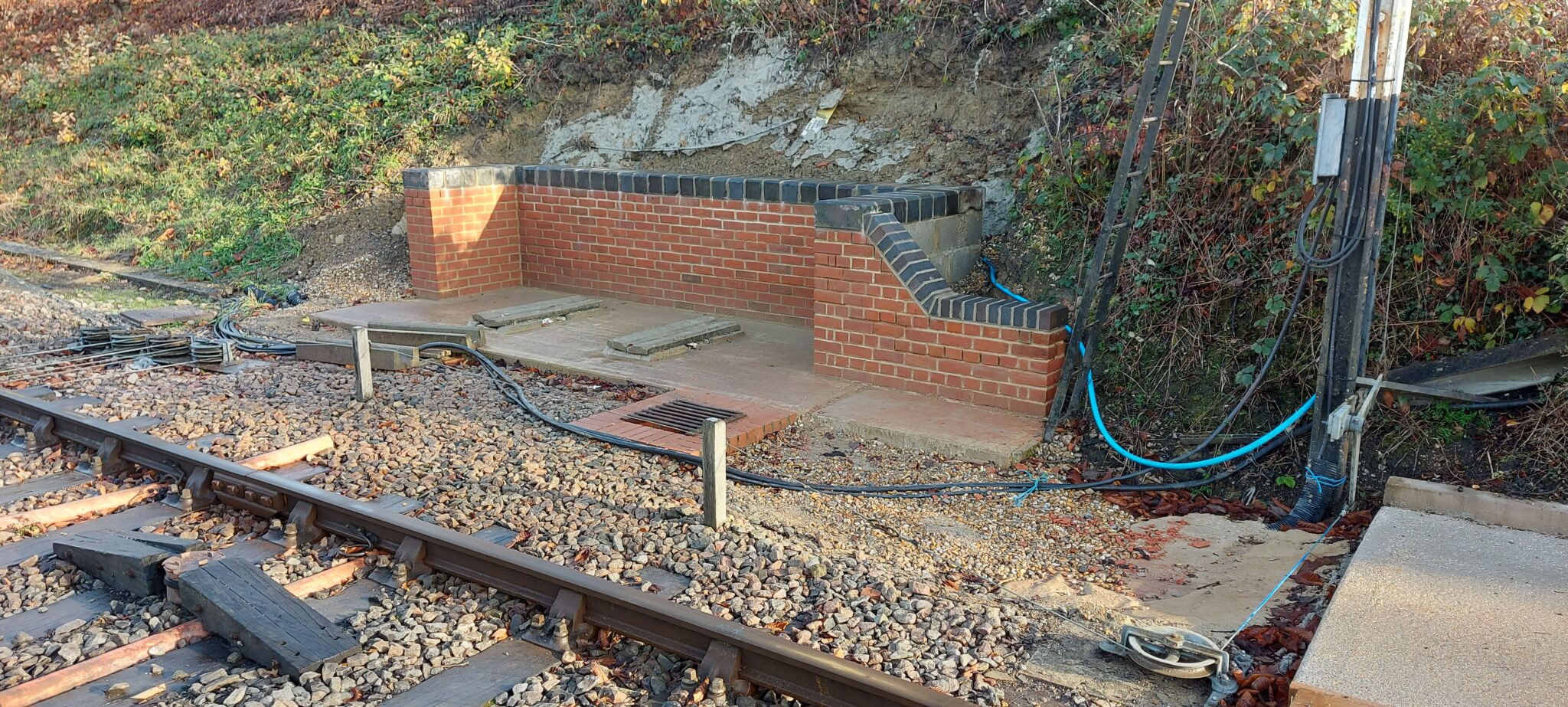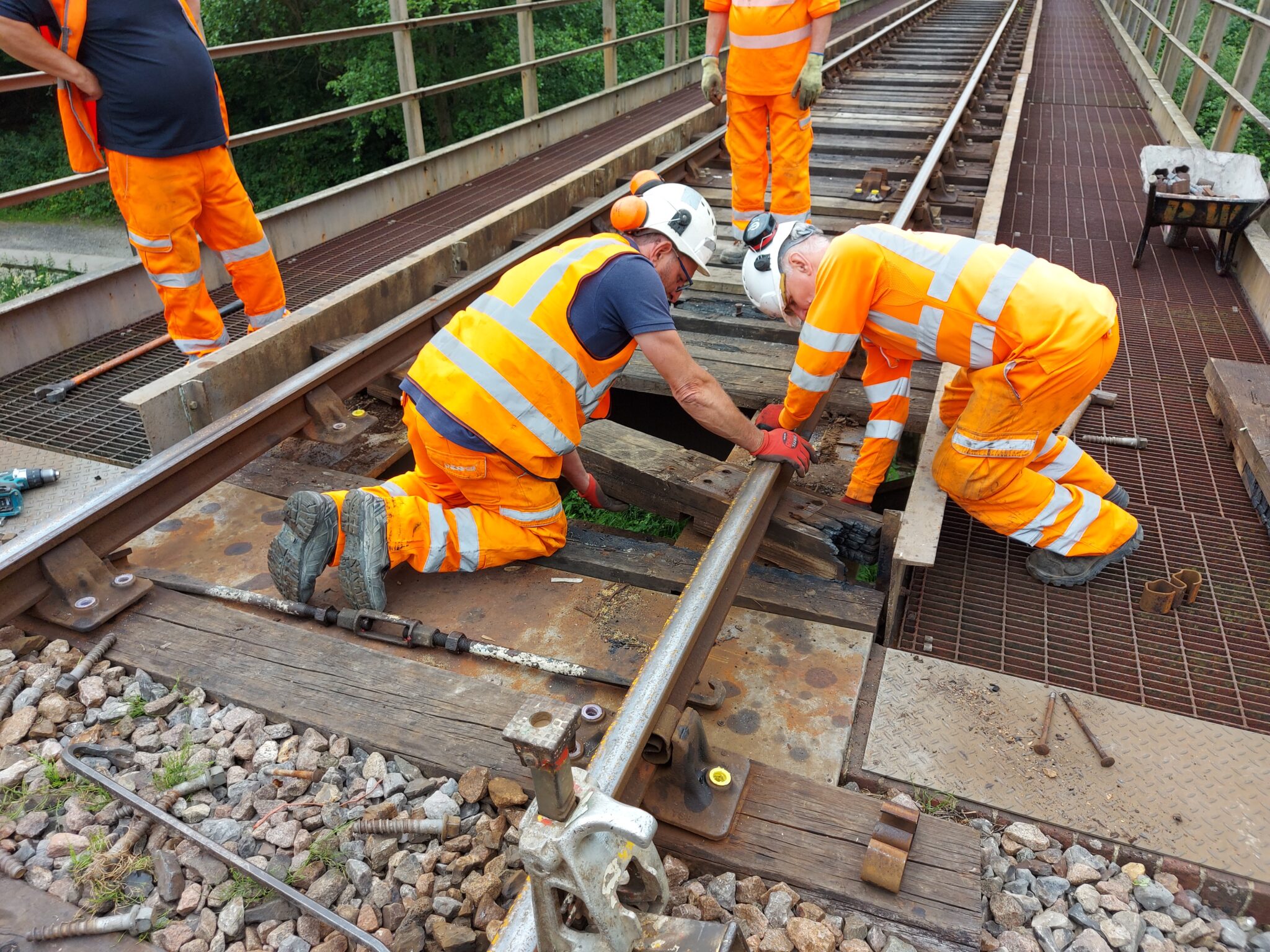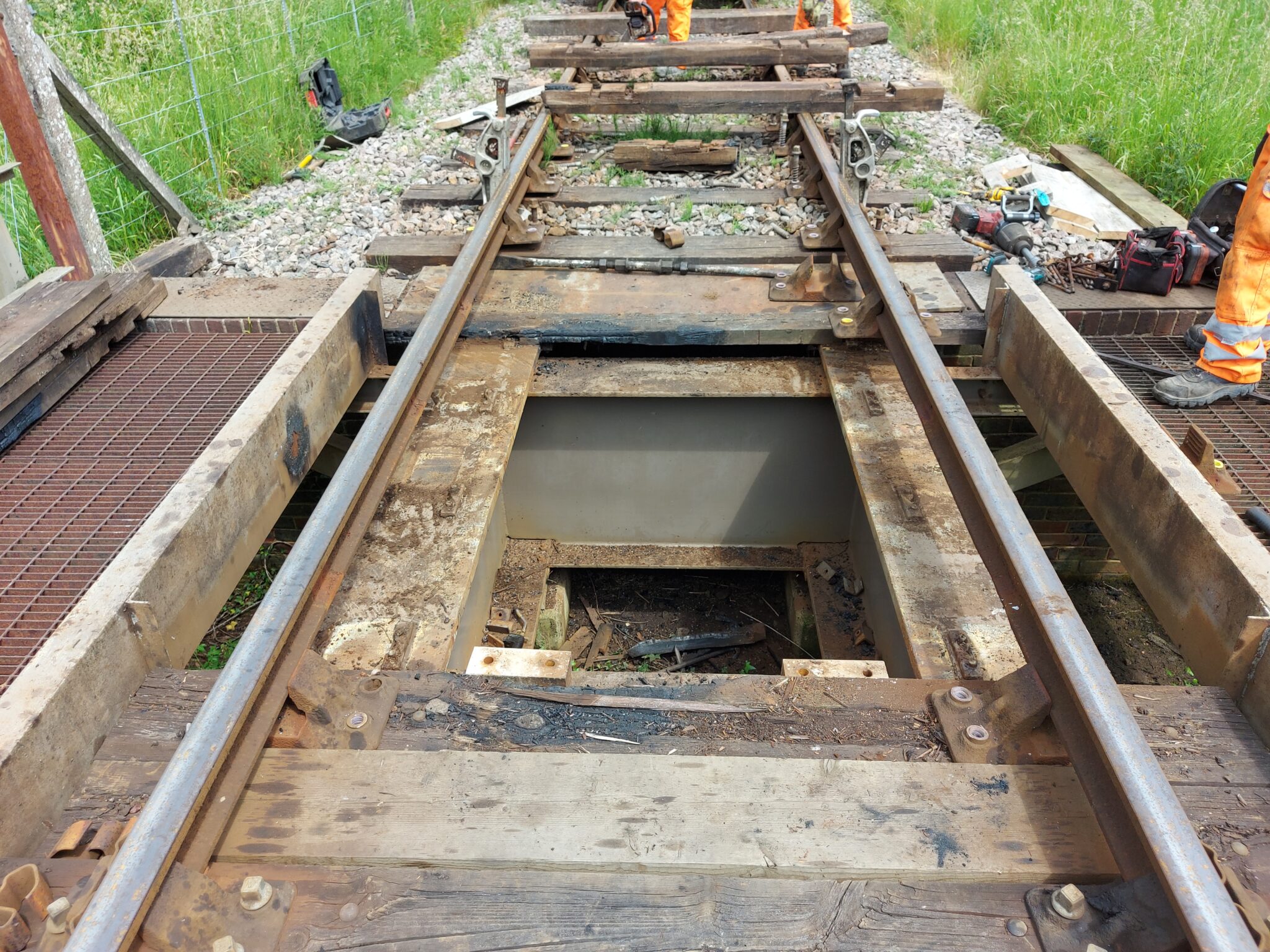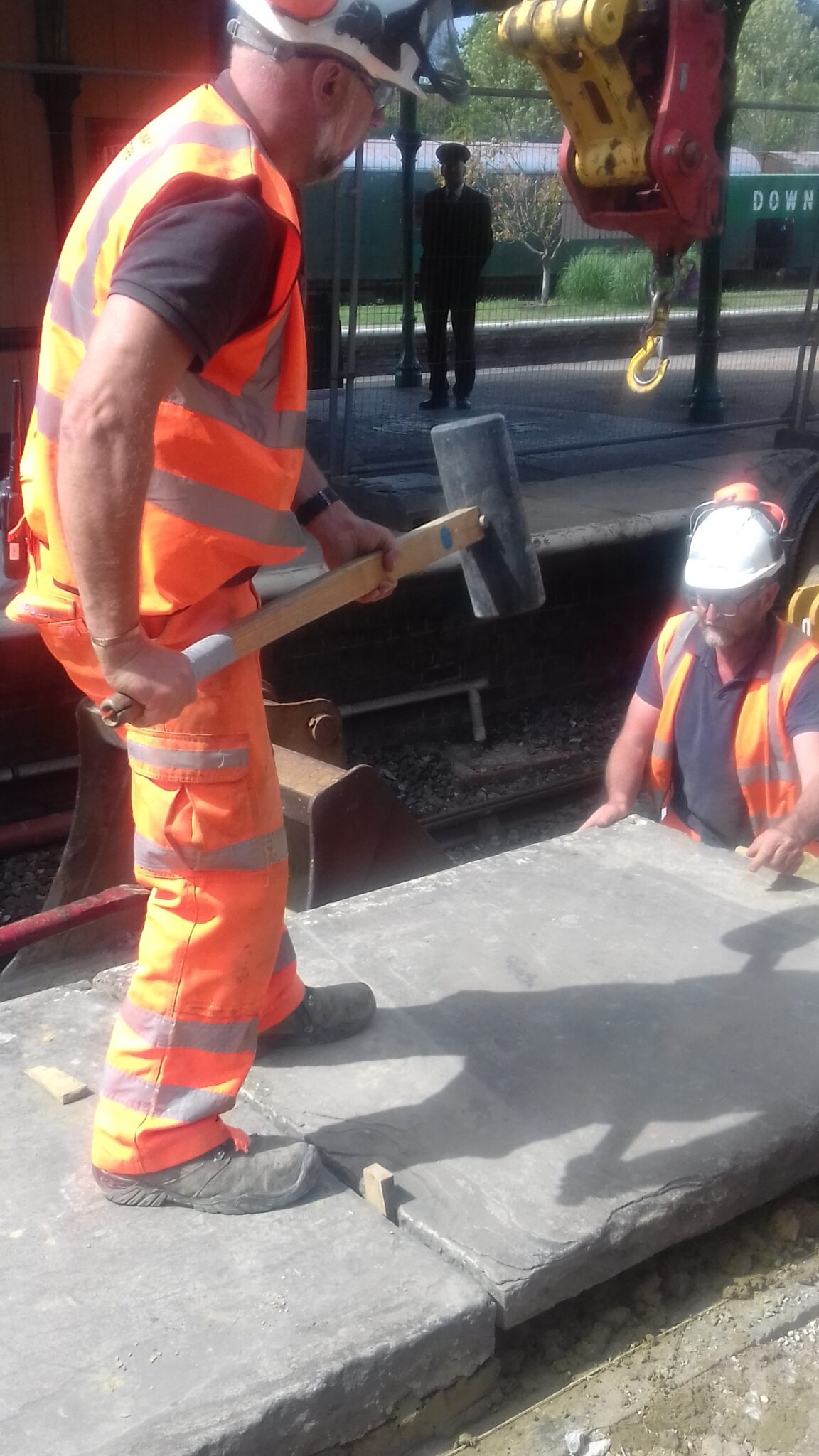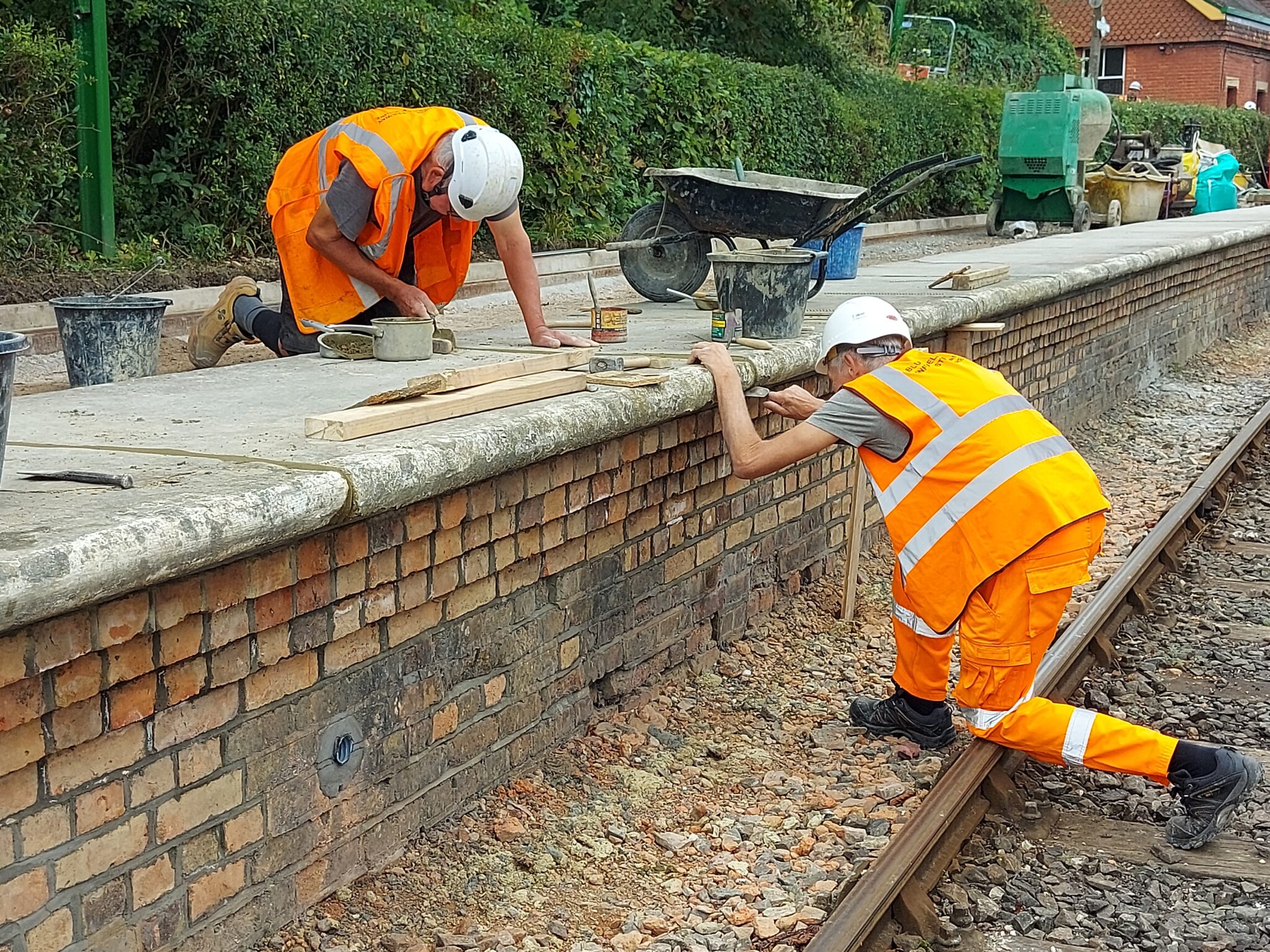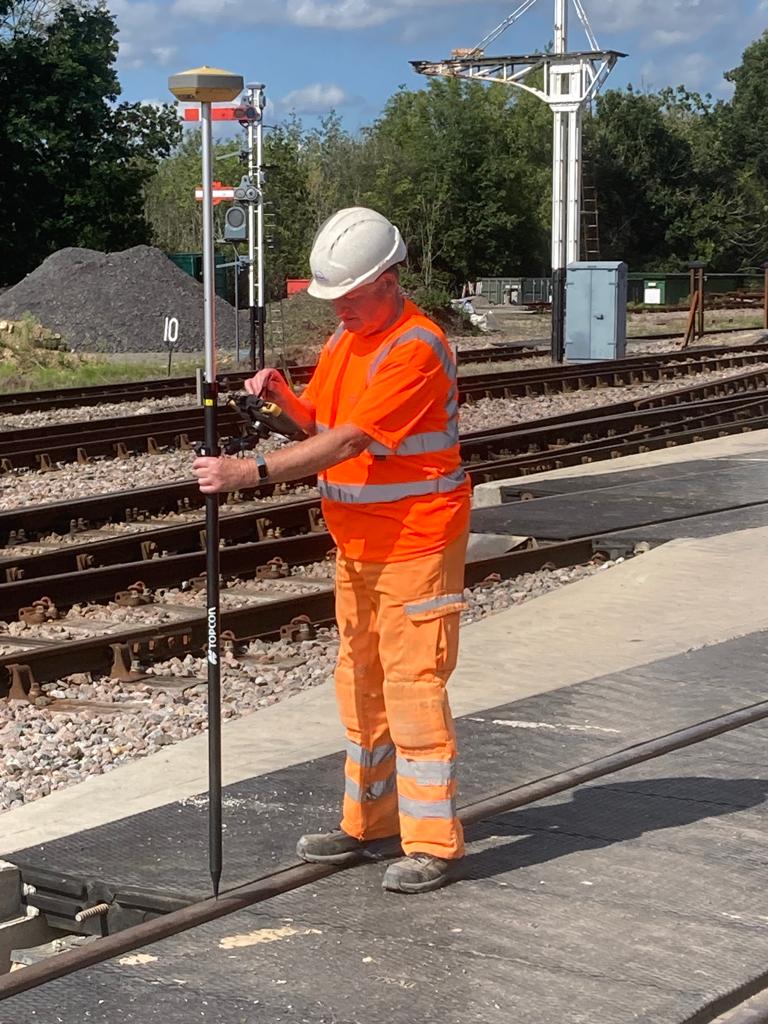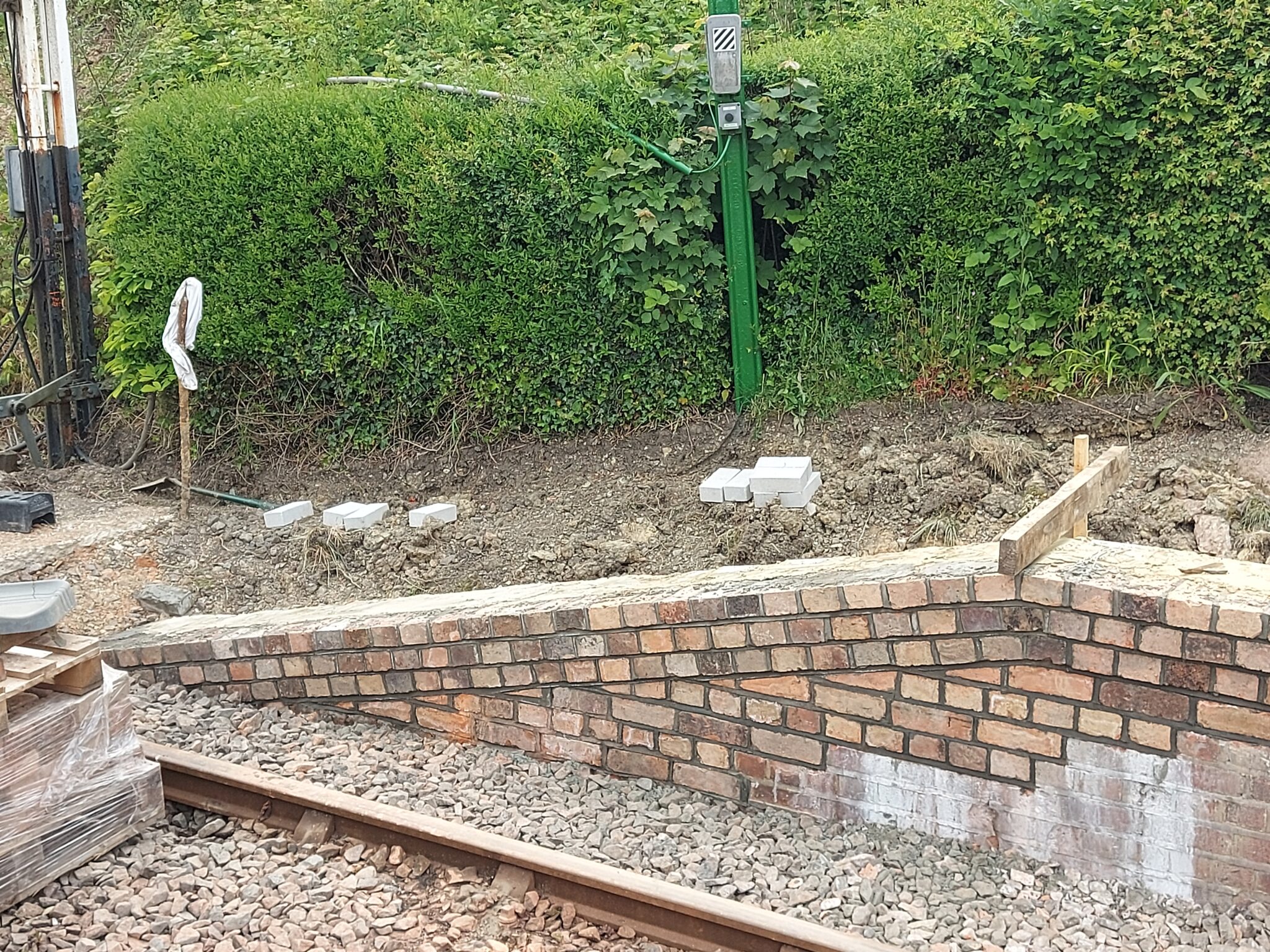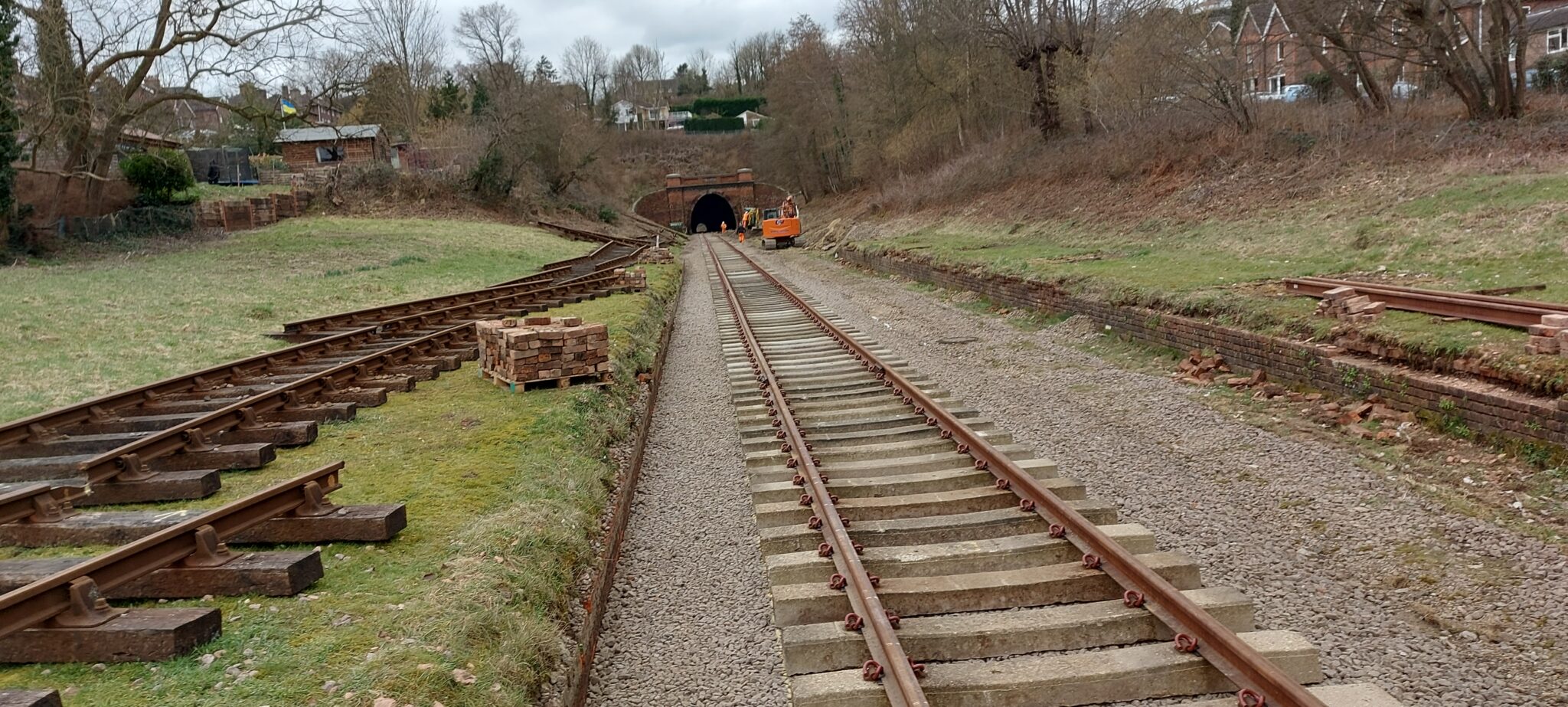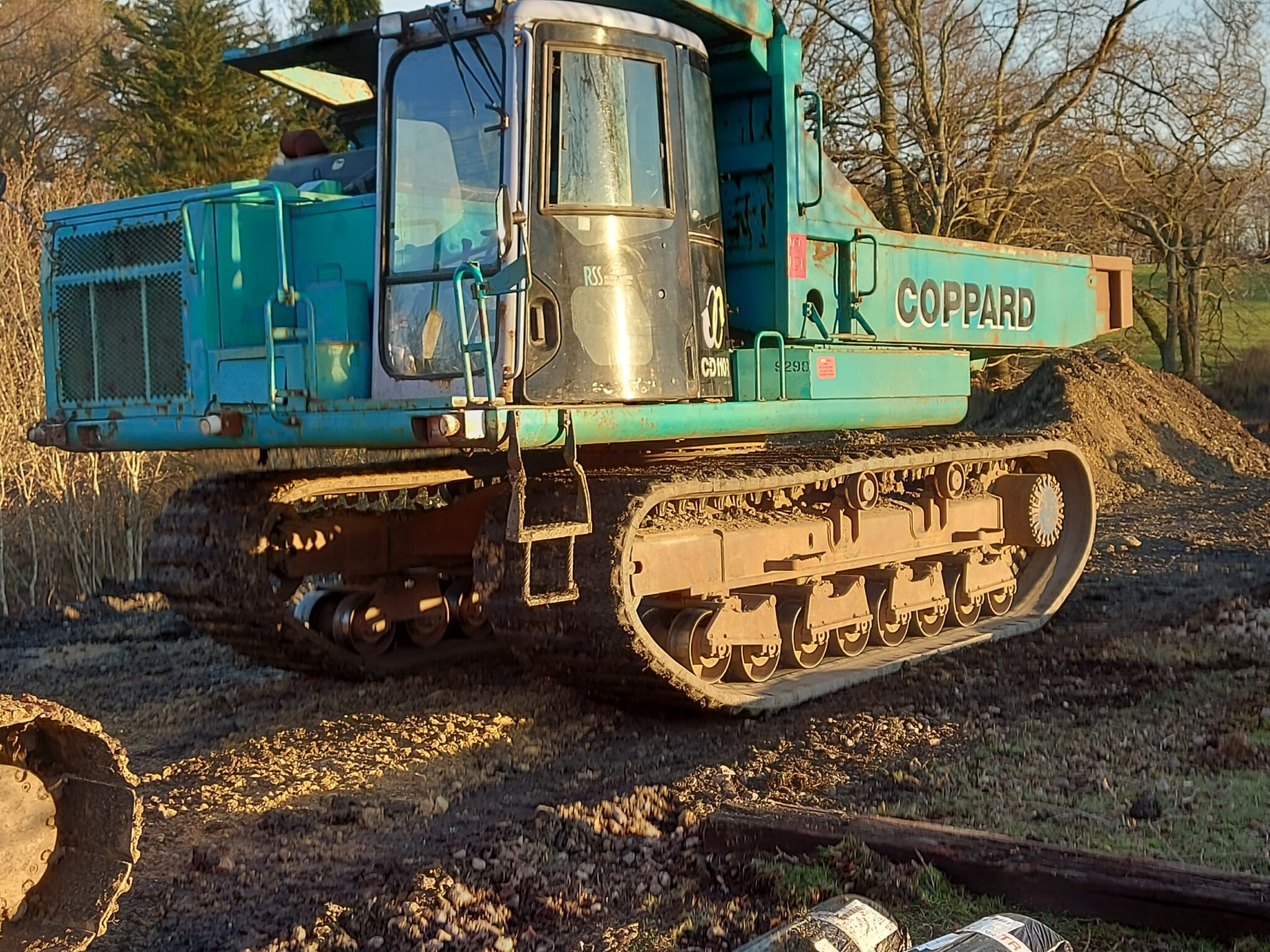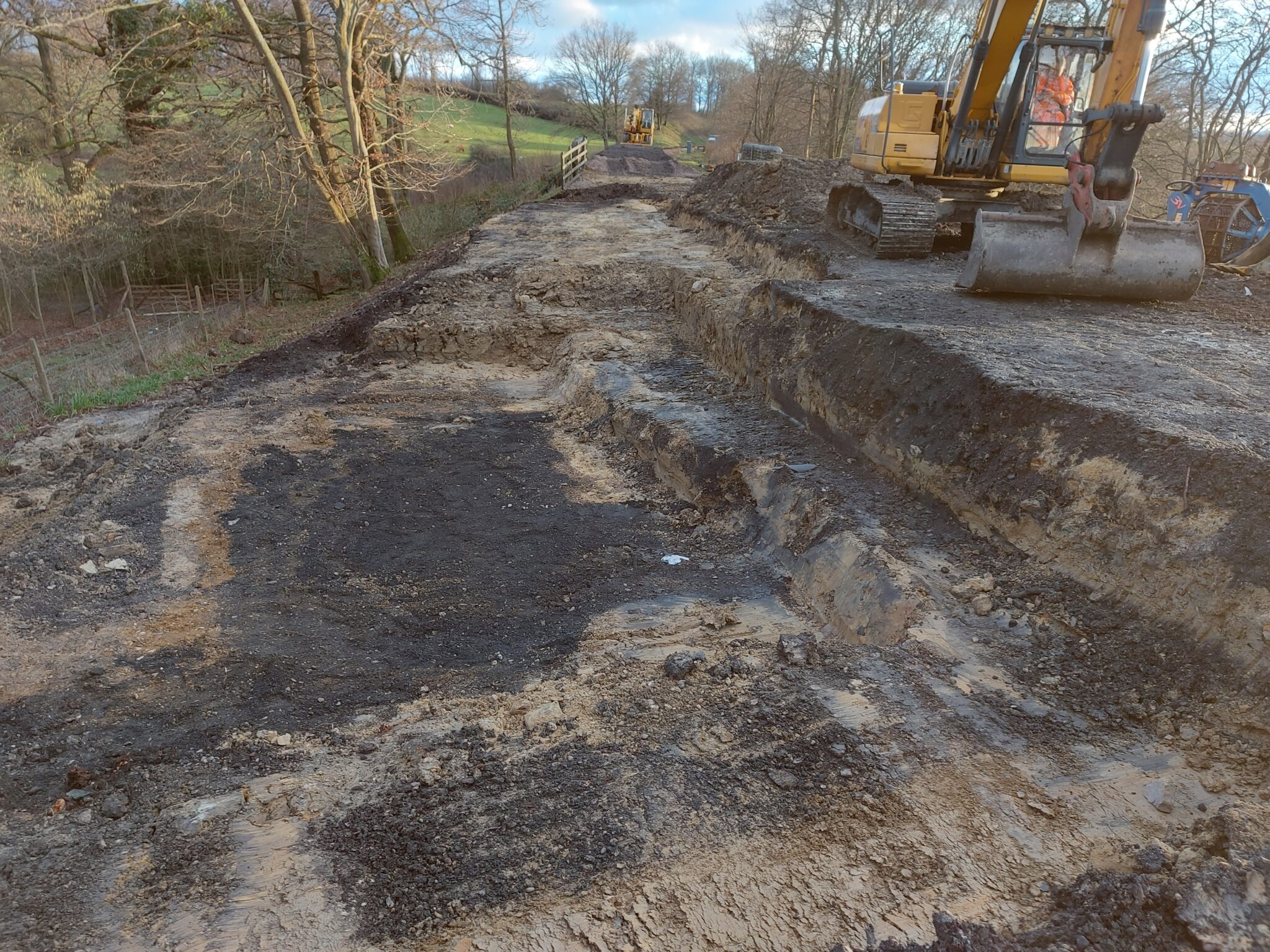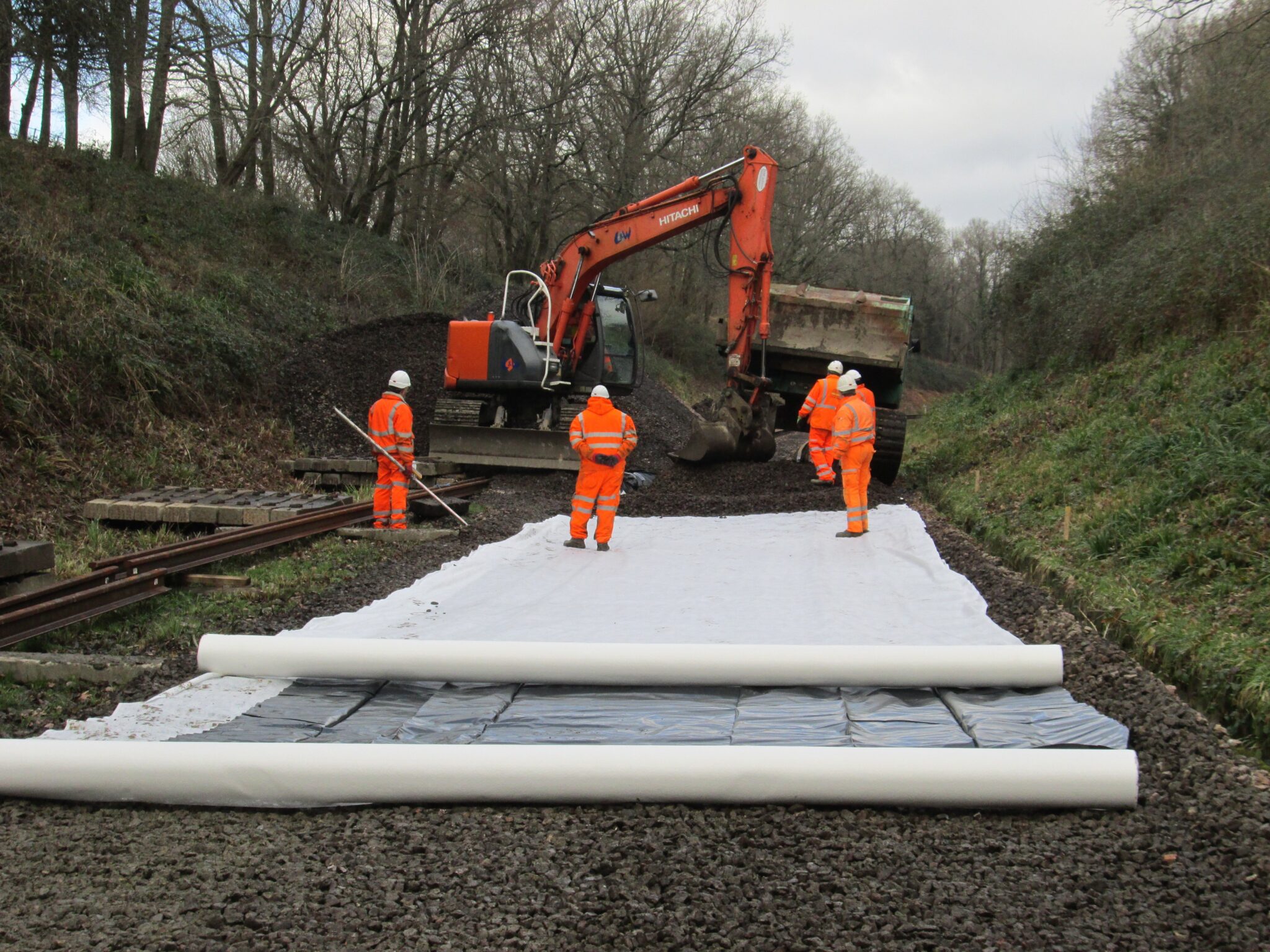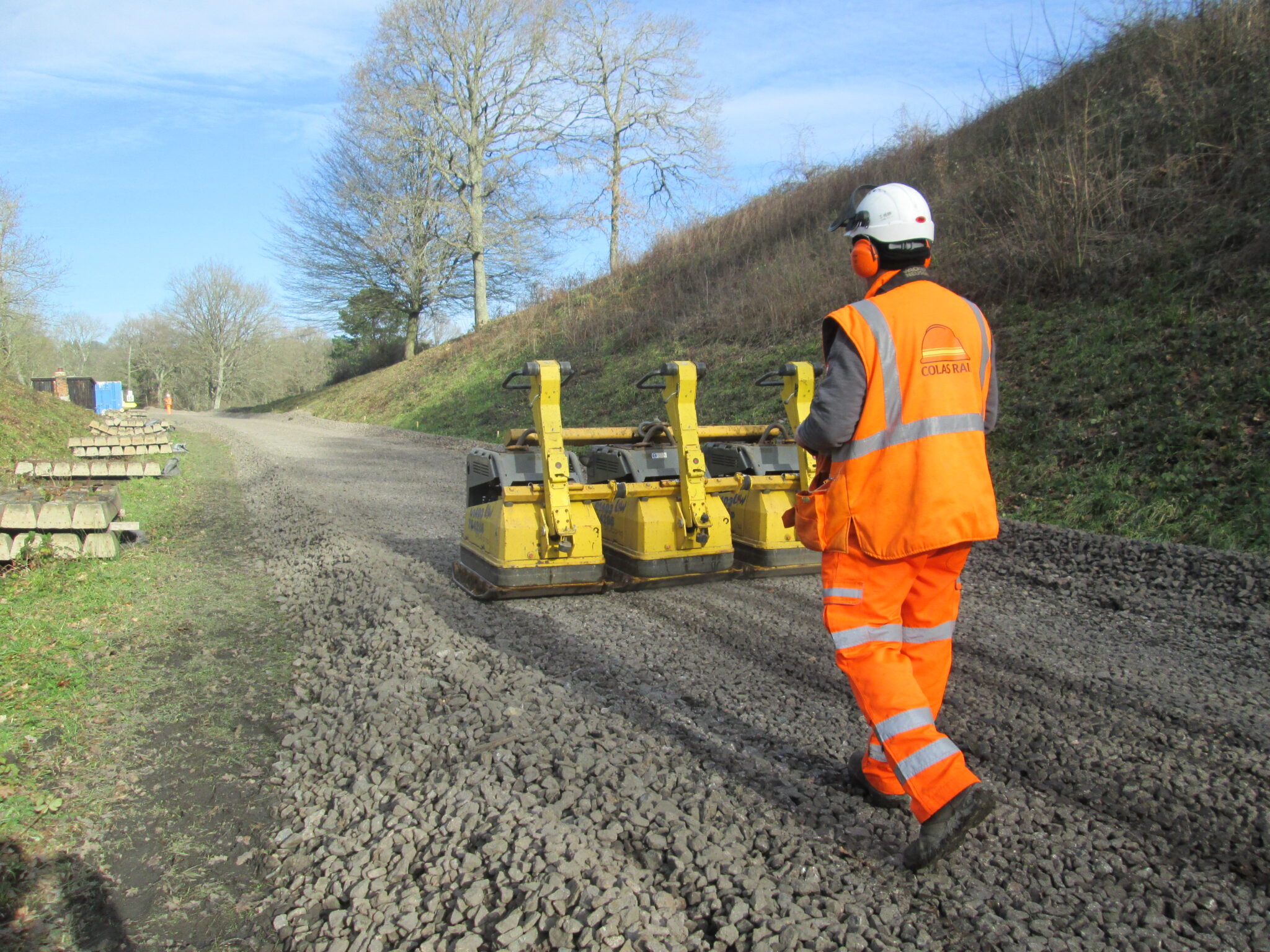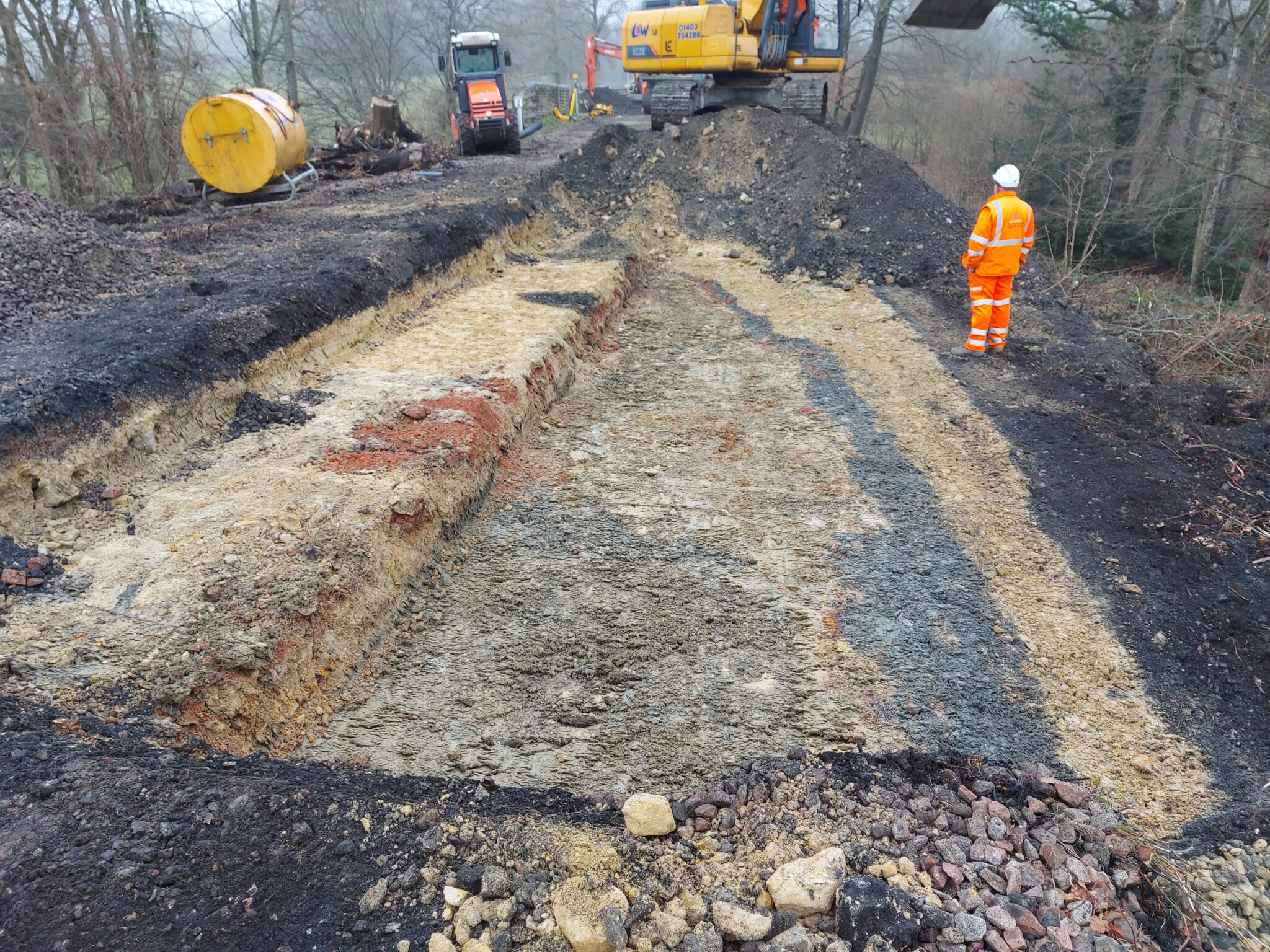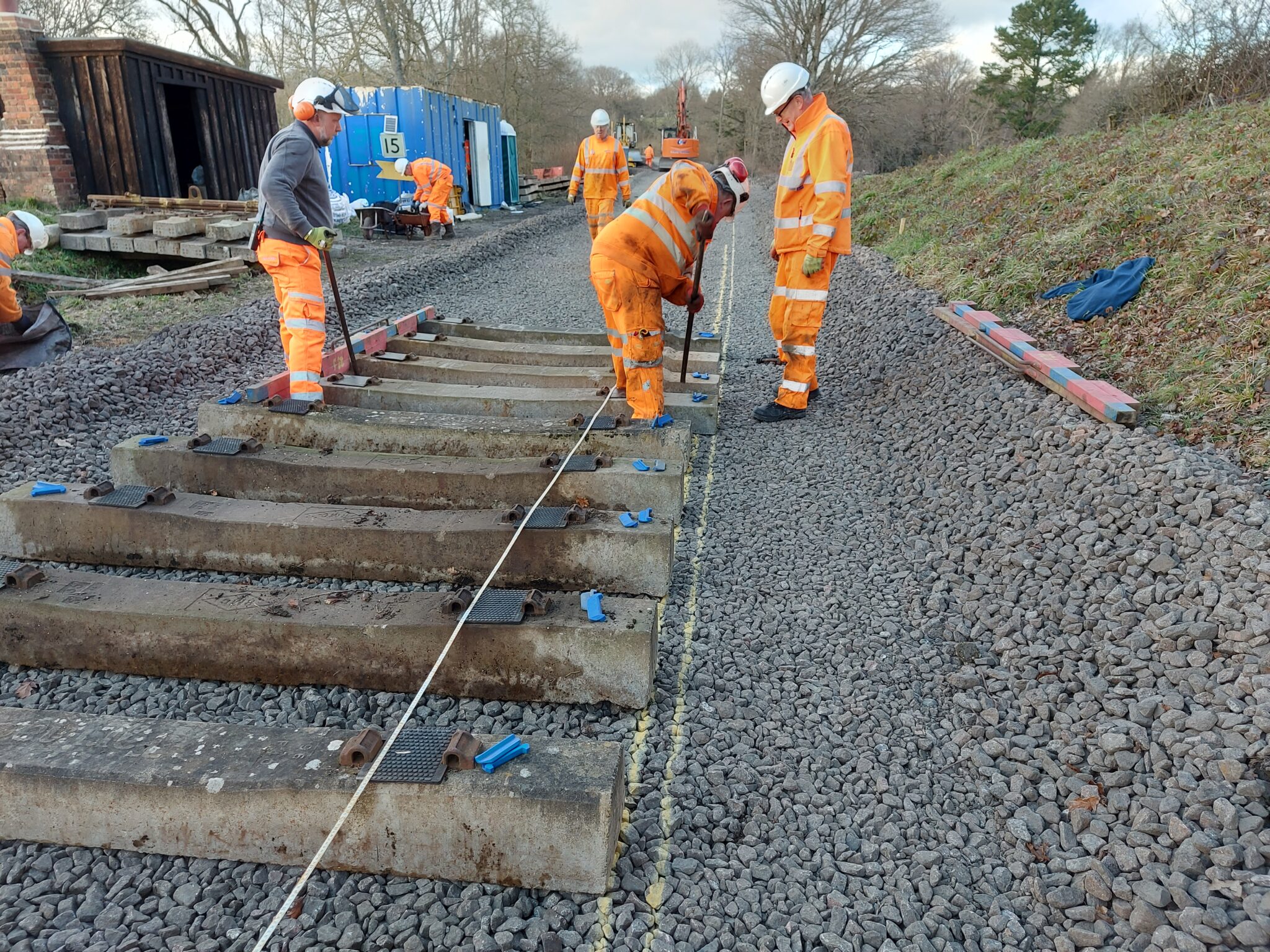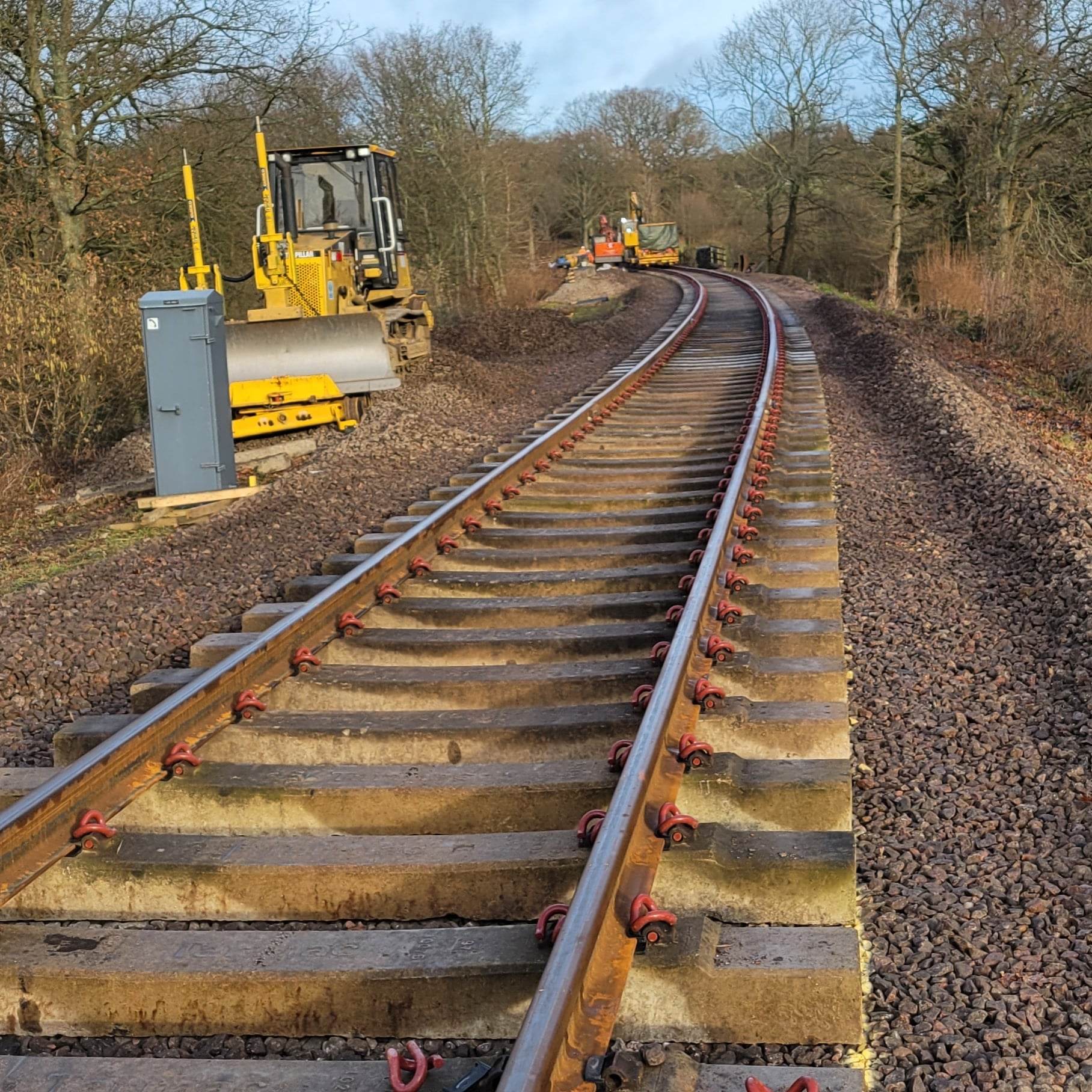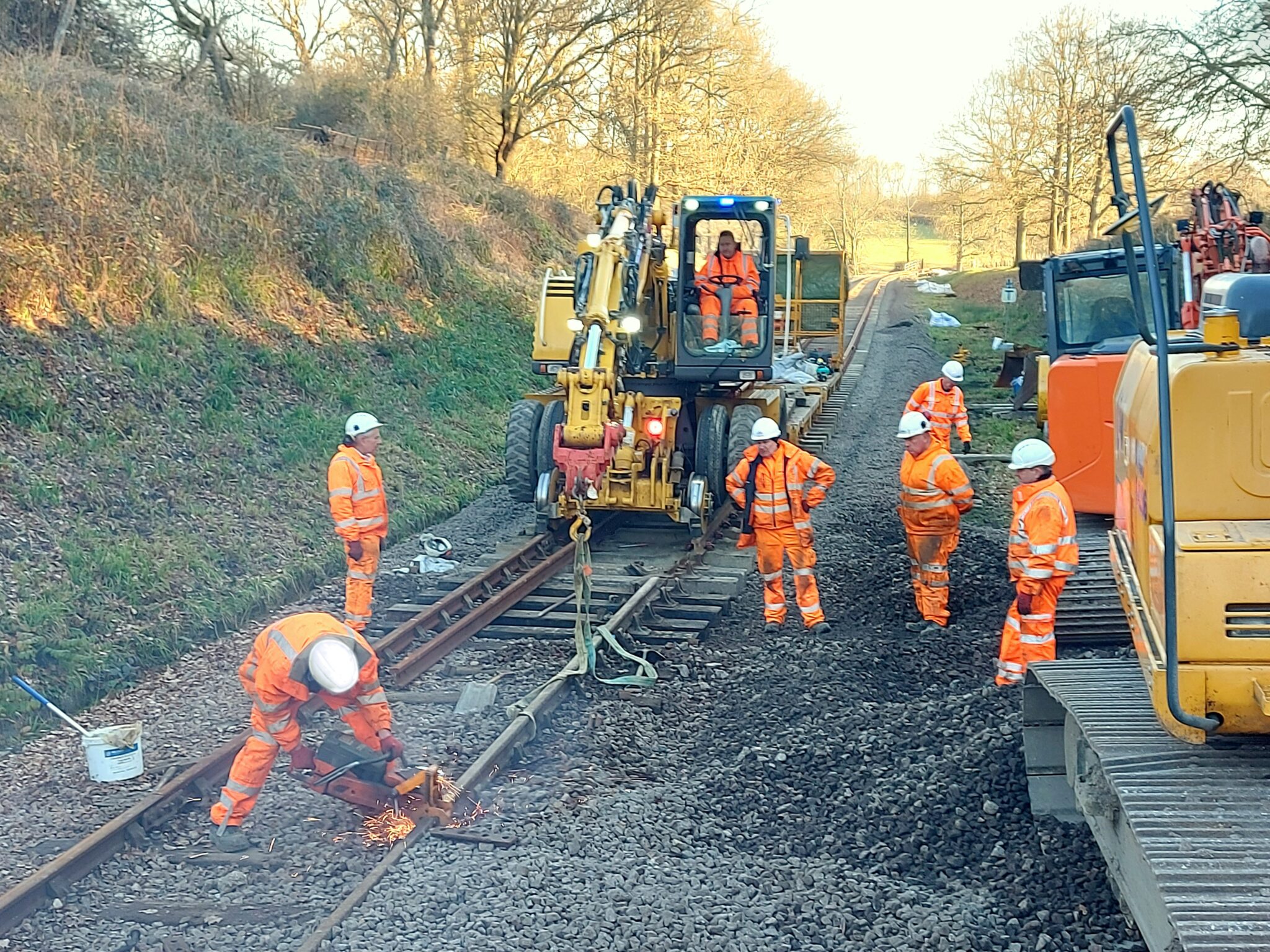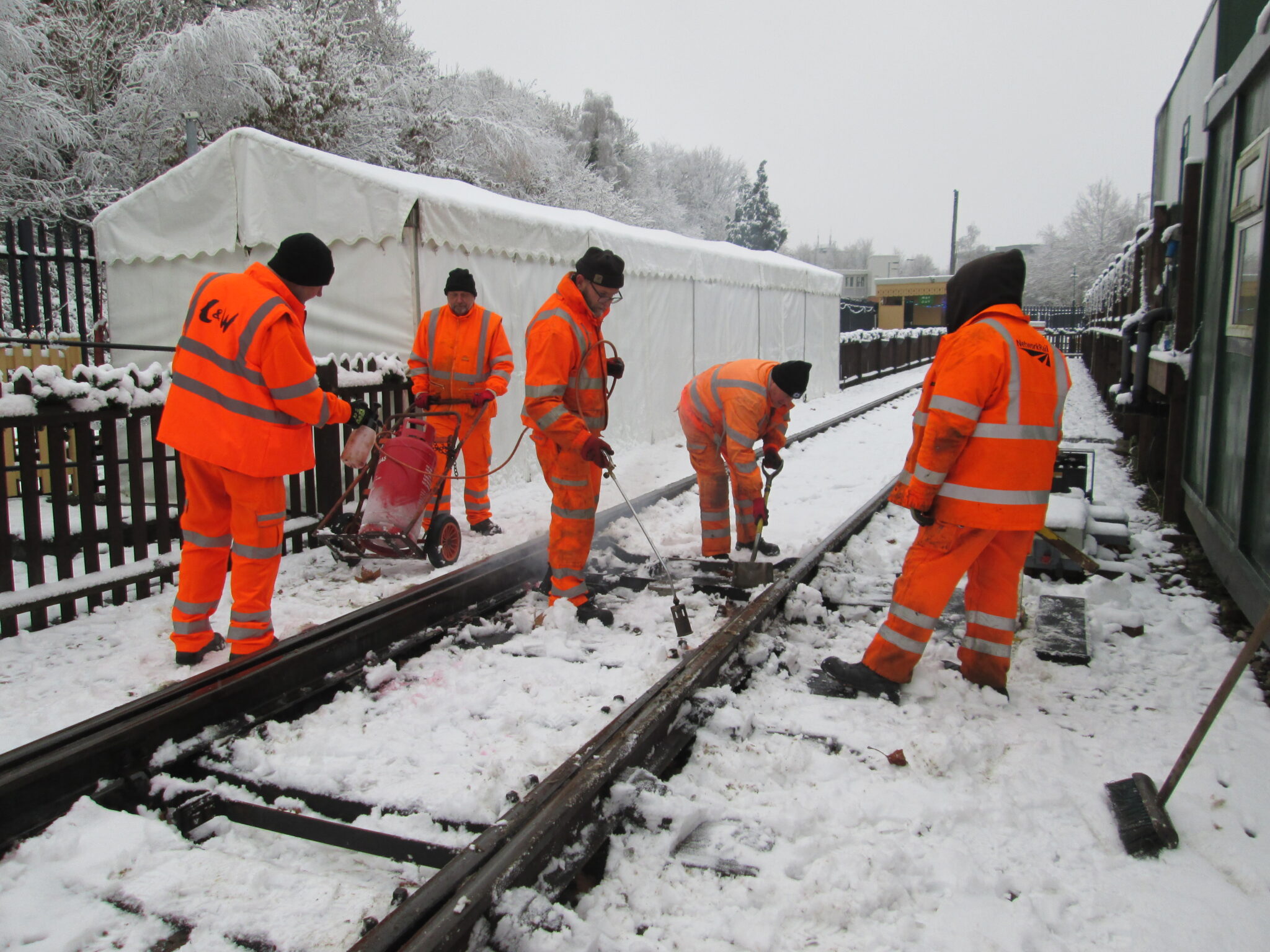
Rail for the tunnel – Winter 2023
An essential part of cost control for the railway is efficient budgeting. The wet conditions and the sulphurous fumes from the engines provide a difficult environment for the track and results is a more frequent relay regime. A financial opportunity arose for the purchase of 28 lengths of 95-pound bullhead rail which is what is used within the tunnel and is what we need to replace in the not-too-distant future, despite being renewed in 2010. Although the replacement will not happen for a few years until the present track reaches its end of life, this opportunity was too good to miss.
‘Trombone’ lorry carrying rail being off-loaded. (Jon Goff)
Preparations for January 2024 Relay – Winter 2023
The track in platform 2 of Sheffield Park together with rebuilding a section of the set of points at the south end of the platform will be carried out during the close down in January.
Most of the bullhead rail there will be reused as it still has some life left in it although the ends of many of the rails are crippled. Therefore, the ends will be cut off and redrilled to create much smoother joints. All the wooden sleepers will be replaced with ‘heritage’ concrete bullhead sleepers which have already been bought and stored at Horsted.
A great deal of preparation goes into these tasks to ensure the work goes smoothly. Acquiring the necessary parts and getting everything in position in good time are essential.
Gauging the track and platform edge in platform (Bruce Healey)
The track bed here has never had any ballast of the correct type, only small-pebble beach ballast, and so it needs to be fully dug out and re-laid from scratch. A lot of new ballast has had to be bought in for the job and is now in a large pile in the Horsted yard.
The growing pile of ballast in the Horsted yard. (Jon Goff)
An early morning delivery of ballast. (Jon Goff)
At the same time as the track relay, the treads on the footbridge are going to be replaced on Platform 1. Platform 2 steps were replaced approximately 3 years ago together with their supporting brackets. New brackets for the new steps were drawn up to a slightly modified design and have been fabricated. They have been heavily galvanized for long term rust prevention and with painting as well, should last a very long time.
New brackets to support the new steps on the footbridge at Sheffield Park. (JG)
Another task will be on platform 1 where sections will be dug up and new cable conduits buried so as to supply new LED lighting to better illuminate the platforms as part of an electrical upgrade and long-term economy measure. There are a number of new platform edge slabs that need to be replaced and these will be the same concrete type as the existing concrete sleepers on both platforms.
Horsted down yard crossing – Winter 2023
More work has been carried out on the Horsted Down Yard crossing. The eventual aim is to provide a crossing over the whole yard. The concrete sections were cast in-house.
Concrete crossing sections being fitted. Jon Goff
Culverts – Winter 2023
With worsening global warming, it is ever more necessary to keep our culverts in good condition. Regular inspection and (where necessary) maintenance are periodically carried out.
Horsted station culvert outlet headwall and Black Hut culvert, west end (Jon Goff)
Platform 1 – Winter 2023
Platform 1 at Horsted Keynes is well known to have been in a terrible state for some time now, which is why much of it has been barriered off and the Carriage Shop has had to move. Now that work has started, a much more substantial barrier has been built as the work will take some time and include the repairs and repaint to the station building on the platform.
To mend the other platforms, many of the stone slabs from platform 1 have been used. Removing these has revealed the worst of the work that needs to be done. Not only has the wall degraded with the top corbel layers tipping over, but a significant section over the brick culvert running across under all the platforms has sunk more than 4 inches (100mm). In addition, large area of the wall has virtually no mortar left between the bricks at all, as the weak lime base mortar used 150 years ago has washed out.
Clearly a lot of new paving slabs will be required to replace those taken from platform 1. Options are still being investigated and will be for some time, as the ideal solution of all new slabs will be very expensive. This solution would involve purchasing enough new slabs, 150 meters of them, to renew the entire platform and save any remaining good ones for future repairs at any of our stations. However, that would cost something like £100,000 whereas the concrete slabs like those in parts of Sheffield Park would cost maybe only £14,000. The decision is likely to take some time as other ideas are being looked at.
Removed slabs from Platform 1 revealing the large amount of brickwork required. The platform barrier is also evident. Jon Goff
Platform 2 and 4 Started – Winter 2023
With platform 5 completed, attention turned to platform 4. Fortunately, a very much smaller job. Due to time constraints, only immediate gauging and safety issues could be addressed. Quite a few slabs needed to be re-bedded slightly further way from the track to provide the correct clearances – and a smoother curve to the platform edge. Many slabs had crept forward slightly over the years due to soil movement under the tarmac behind them and poor bedding under the slabs. Some minor realignment of the track was also necessary.
Platform 4 maintenance. The worn-out corbel bricks were replaced and the edge slabs reset. A long-abandoned bird’s nest was found under the platform edge in a disintegrated brick. (Jon Goff)
Gauge checking platform 2 and resetting groups of slabs. Jon Goff
This work is finished at the north end but is more work is still required at the south end and a few delaminated slabs will have to be replaced in the centre section, all “borrowed” from platform 1.
Sunday Gang – Winter 2023
While this news page concentrates on the work of Matt Crawford’s team, there are many other teams doing sterling work which often goes without mention. The two Wednesday and Tuesday lineside teams, the fencing gang and the Saturday track patrols to mention a few. Here we see the Sunday gang maintaining the track.
Paul Bailey and Tim Kemp use the Robel tampers at New Road Bridge 12 Nov 2023 (Jon Bowers)
Platform 5 Finally Finished – Winter 2023
A huge amount of work has been carried out with a lot of pipes and conduits now hidden under the new, very tidy and smartly laid surface. The junction between the path from the staff car park and the platform with the uneven drain cover has gone through a major transformation. It is now very smart, safe and tidy. The issue of water draining down into the area and has also been resolved. Other details have been improved such as the pipework and brickwork/benching around the drains.
The renewed safe accessible route to the other platforms. (Jon Goff)
Before and after images looking north on Platform 5 (Jon Goff)
All images Jon Goff
Replacing Cabinets at the End of Platforms 3 and 4 – Winter 2023
Work towards getting rid of the old cabinet of the ends of platforms 3 and 4 is progressing with the Signal and Telecom (S&T) department painstakingly transferring cables wire by wire. There are a lot of wires involved especially in the big multicore cables as well as power to various signals and point motors etc, track circuits and telecoms as well.
S&T decommissioning the old cabinet. The new site for the new cabinets (Jon Goff
Newcombe Bridge – Autumn 2023
Urgent repairs were carried out to Newcombe Bridge after some of the sleepers had been damaged by dropped cinders.
Left image – Fire damaged sleepers. The furthest one has already had the centre section cut out – Jon Goff
Centre and right image – Removing the old sleepers with the rails jacked up – Jon Goff
Horsted Keynes Platform 5 – Autumn 2023
Work to relay platform 5 continues.
A lot of reinforcement in the concrete behind the support wall and one of the coping stones being lowered into place on top and bedded down by Andy Palmer. Bruce Healey
Left and centre images: With the safety fencing temporally removed to allow the road railer in a better view of the platform and ramp to the crossing is available. Bob and Steve busy doing the pointing between the copings – Jon Goff
Right image – The new rail-gully now in place – Bruce Healey
Lifting the coping stones under the refurbished canopy and Darren digging another drainage trench – Jon Goff
Breaking off the top layer of concrete and Flat sub base laid down – Jon Goff
New Surveying Equipment – Summer 2023
We have been fortunate enough to purchase a new piece of surveying equipment which, although expensive, will save a lot of money in the long run. Over recent years, we have had to pay out for professional surveys carried out around the railway and these have cost thousands of pounds each time. We will be able to do these ourselves in the future and plot the results in a CAD drawing package to produce drawings in a format that can be easily understood.
Left image – The controller and the satellite receiver. – Jon Goff
Centre image – Surveying with the new equipment. – Barbara Watkins
Right image – Survey results with annotations – Jon Goff
Platform 5 – Summer 2023
One of the problems with platform 5, if not the major issue, is that over time, the edge coping stones have tended to move outwards, reducing the clearance to the trains and has put a ban on the passage of a few wider vehicles past the platform. Water and soil pressure from the bank behind the platform are likely to be the main cause of the movement. Rain water has certainly washed out much of the mortar from between the bricks.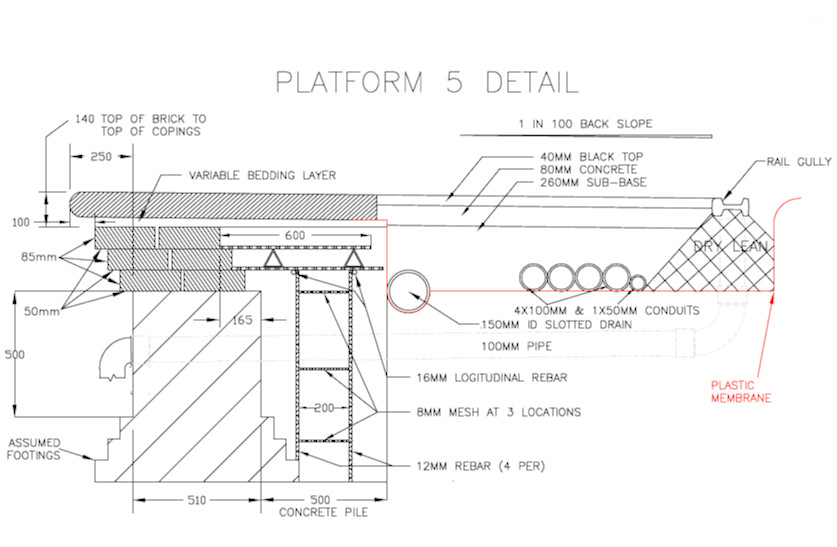
A rebuild of the platform had become a matter of urgency and the work is well under way. To prevent this movement happening again in the future, the rebuild will anchor the stones in place as in the diagram, which has now become an official build design.
All corbel layer bricks removed together with many from the wall below. (Mike Hopps)
The work is being carried out by contractors, assisted by members of the infrastructure team with the appropriate skills for the particular task in hand.
Left image – Limited Site access – full PPE and clothing with hard hats area. (Jon Goff)
Centre image – Corbel layers finished including the end ramp. (Jon Goff)
Right image – New plinth area for S&T location cabinets under construction. (Jon Goff)
Continued laying of cable conduits – Summer 2023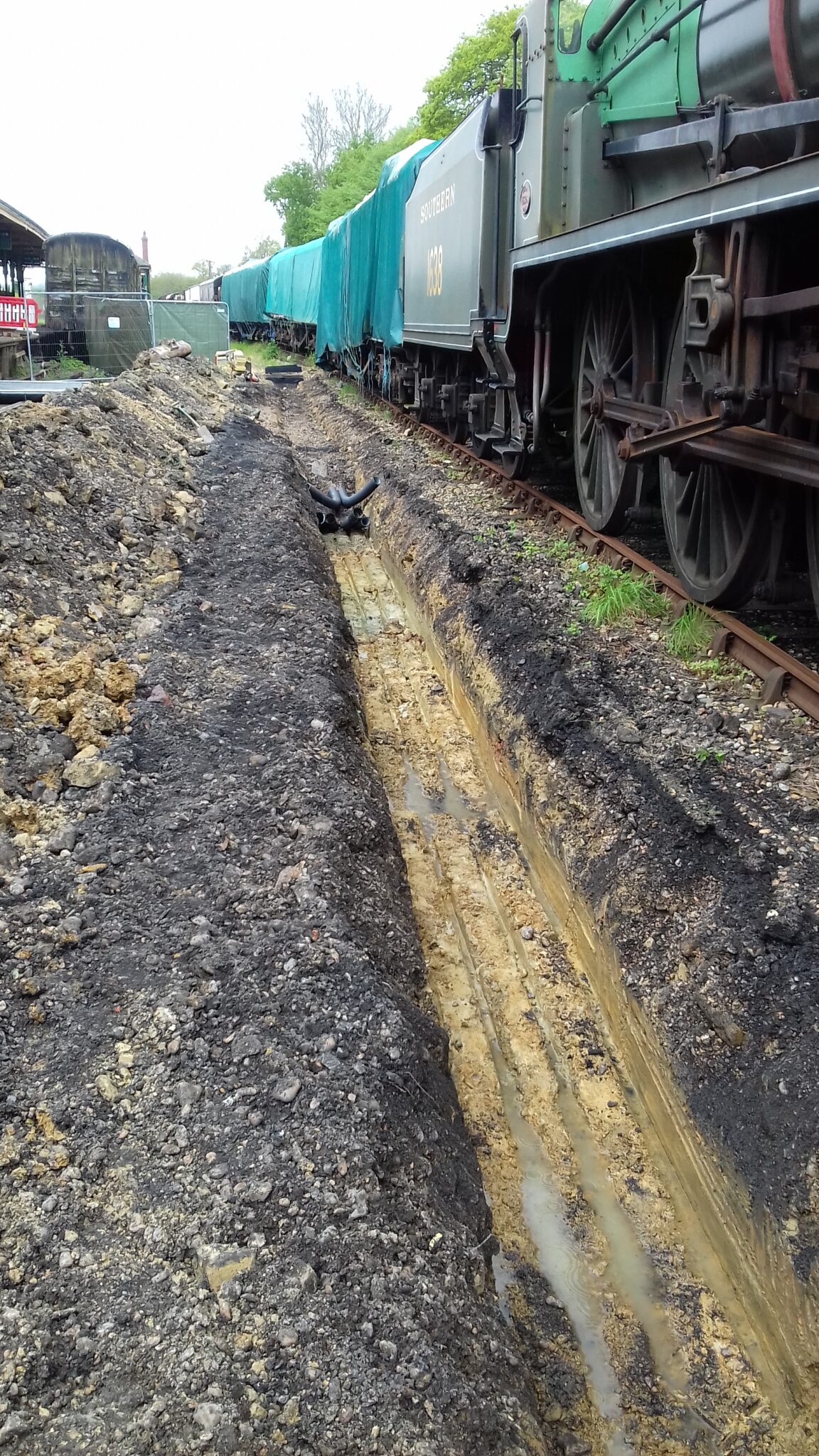
Continued trenching and inserting of cable conduits between roads minus 1 (the second siding beyond Horsted Keynes Platform 1) and road minus 2. Photo – Bruce Healey
The second track re-lay project – north of the tunnel – Winter 2022-3
This relay was just 10 panels of track, between the tunnel and the foot crossing at West Hoathly.
Left image – Pulling back the ballast to put in the plastic layer at West Hoathly. – Jon Goff
Centre image – Lowering in the new rail. – Tim Crump
Right image – The reconnected track from tunnel to foot crossing ready for ballasting. – Jon Goff
Infrastructure’s principal winter task – Vaux End Bridge civil engineering project – Winter 2022-3
There were two issues in the area that needed to be addressed, apart from the worn-out track. The most visibly obvious problem was the huge depth of ballast over the bridge as mentioned in the last issue of Bluebell News. The other issue was that there have been land slips in the past, some of them right back in Victorian times. These have been repaired by dumping ash in the holes left by the slips instead of digging them out, cutting in horizontal steps, layering and compacting them properly and so they have sunk again. This problem has been compounded by burrowing animals, principally rabbits. They love digging into the ash repairs as it is much easier easy for them than mudstone or clay, and over time the burrows fall in and settle thus slowly lowering the track bed.
To determine exactly what we needed to do to find a permanent solution, we had to do a lot of digging out and seeing what was there. We had an idea that there were old land slips forming part of the problem but not the details of the slips. We knew that the track needed to be lowered by 400mm over the bridge to bring the track level back to what we believe was correct for the bridge design. The profile of the line also needed to be addressed as this had become somewhat irregular with time.
Top Right: Hired in tracked swivelling dumper for moving the ballast out of the way up at the top end of the job. – Jon Goff
Left image – Benching steps cut into the embankment removing most of the black ash used to fill the old slip. Jon Goff
Centre image – The vibrating compactor squeezing down the layers of the refilled soil mixture – Jon Goff
Right image – Waterproof membrane starting to go in where embankment rebuilding was not required – Kevin Tucker
Most of the old slip was dug out north of the bridge, which had been repaired at some time in the past using ash. This used to be a common practice but ash is weak and not good for embankments. Benching steps were cut in at 500mm intervals where stabilizing geogrid was laid at each level when being refilled. Each layer was filled in a few inches at a time, and compacted before the next layer was put in. The fill was made up of the ash and sandstone/sandy soil that were mixed together with some cement dust to form a more stable mixture.
Left Image – A new cross drain being dug in. Right Image – The depth of the ballast prior to digging out and relaying – Jon Goff
Left image – Andy Palmer whacking the ballast down firm and smooth with the triple Wacker. – Tim Crump
Centre image – Clear strategic layers of the second slip partly dig out – Jon Goff
Right image -The team marking out the line for the sleeper ends using the Theodolite for the datum. – Jon Goff
Left image – The first sleepers go in. – Jon Goff
Centre image – Aligning and spacing the sleepers in the change-over area. – Jon Goff
Right image – First half completed. Photo – Charlie Tardif who came over for Canada specifically to help
Left image – Matt Crawford cutting in the final rail. – Jon Goff
Right image – Ballast ploughed ready for tamping. – Tim Crump
Deicing Points – Winter 2022-3
The team de-icing the run-round points at East Grinstead. From left to right – Darren Poulter (L&W contractor, not in his RRV cab but squirting de-icer onto the rails) Andy Palmer on the bottle, Matt Crawford, (infrastructure manager and flame thrower) Jon Goff (shovelling it) and Dave Wilson -er- watching (Safety Inspection and Management) Photo by Tim Crump who had also been shovelling it!
Urgent platform repairs – Winter 2022-3
 Horsted Keynes platform 5 suddenly required some attention after an inspection by our track safety inspector, Dave Wilson. It has been known that the platform 5 support wall has being decaying for some time leading to misplacement of the platform edge flag stones. This had got a lot worse following the winter frosts where the mortar under the flag stones had been pushed out by the frosts, hence this particular inspection was required.
Horsted Keynes platform 5 suddenly required some attention after an inspection by our track safety inspector, Dave Wilson. It has been known that the platform 5 support wall has being decaying for some time leading to misplacement of the platform edge flag stones. This had got a lot worse following the winter frosts where the mortar under the flag stones had been pushed out by the frosts, hence this particular inspection was required.
Temporary platform edge support under platform 2 at Horsted Keynes. – Jon Goff
Whistle boards – Winter 2022-3
Mark Duhig has taken on producing two new Whistle boards for the Tremaines crossing, half way between Sheffield Park and Horsted Keynes. Observers on the train will have noticed that the existing ones, especially the north bound board were in a particularly bad condition and so here is a picture Mark took of one of his excellent replacement boards.
With huge thanks to Barry Luck, Jon Goff, Mike Hopps, Kevin Tucker, Brian Kidman and Bruce Healey.

